History of Wraeclast: Difference between revisions
(→Oriath) |
Bloonpauper (talk | contribs) No edit summary |
||
| Line 48: | Line 48: | ||
== The Azmeri == | == The Azmeri == | ||
{{main|Azmeri}} | |||
=== Encountering the Vaal (c. 900-400 BIC) === | === Encountering the Vaal (c. 900-400 BIC) === | ||
The Azmeri people hail from the Azmerian Mountains <ref>Eramir: "The Azmeri. The culture that descended from the Azmerian Mountains and founded the Eternal Empire, so long ago."</ref>. They first encountered the Vaal about 500 years before the Vaal fell, or about 900 BIC<ref>Math: Imperialus Conceptus happened 400 years after the Vaal fell (see later notes). According to ''Raising the Azmeri'', "the first Vaal refugees came knocking five hundred years" after the Azmeri first encountered the Vaal.</ref>. The Vaal helped the fledgling Azmeri civilization advance<ref>Library book ''Raising the Azmeri'': Vaal civilisation held the hand of the Azmeri as they grew from a primitive tribal existence into a cohesive culture of settlement and agriculture</ref>, | The Azmeri people hail from the Azmerian Mountains <ref>Eramir: "The Azmeri. The culture that descended from the Azmerian Mountains and founded the Eternal Empire, so long ago."</ref>. They first encountered the Vaal about 500 years before the Vaal fell, or about 900 BIC<ref>Math: Imperialus Conceptus happened 400 years after the Vaal fell (see later notes). According to ''Raising the Azmeri'', "the first Vaal refugees came knocking five hundred years" after the Azmeri first encountered the Vaal.</ref>. The Vaal helped the fledgling Azmeri civilization advance<ref>Library book ''Raising the Azmeri'': Vaal civilisation held the hand of the Azmeri as they grew from a primitive tribal existence into a cohesive culture of settlement and agriculture</ref>, | ||
but guarded their knowledge of Virtue Gems<ref>Library book ''Raising the Azmeri'': Though they described the Vaal as having flesh adorned with glittering crystals, our Azmerian ancestors were never privy to the gems’ potential or powers.</ref>. | but guarded their knowledge of Virtue Gems<ref>Library book ''Raising the Azmeri'': Though they described the Vaal as having flesh adorned with glittering crystals, our Azmerian ancestors were never privy to the gems’ potential or powers.</ref>. | ||
| Line 56: | Line 55: | ||
After the Vaal fell, 3,126 Vaal refugees assimilated into the Azmeri civilization<ref>Library book ''The Fall'': "Three thousand one hundred and twenty-six: the number of Vaal refugees who came to live with and eventually become absorbed into the Azmerian people."</ref>. | After the Vaal fell, 3,126 Vaal refugees assimilated into the Azmeri civilization<ref>Library book ''The Fall'': "Three thousand one hundred and twenty-six: the number of Vaal refugees who came to live with and eventually become absorbed into the Azmerian people."</ref>. | ||
=== | ===Founding the Eternal Empire=== | ||
The Eternal Empire was founded by the Azmeri, who descended from the [[Azmerian ranges]] down to the lands left behind by the [[Vaal Empire]], destroyed by the [[Vaal Cataclysm]].{{efn|[[Eramir]], "The Azmeri"}} They may have been led by the visions of a young [[Azmeri]], Egrin. Later, Egrin was cast out for these visions, possibly related to [[The Elder]], and taken in by the [[Order of the Djinn]].{{efn|[[Order of the Djinn]], "{{il|Rusted Elder Scarab}}"}} | |||
==Eternal Empire (1 IC - 1339 IC)== | |||
{{main|Eternal Empire}} | |||
===Imperialis Conceptus (1 IC)=== | |||
The founding of the Eternal Empire is known as "Imperialis Conceptus", and marks the first year of the Eternal calendar, 1 IC. | |||
"Eighty thousand tribesmen and women" of the Azmeri, led by Tarcus Versuso, descended Azmerian ranges and headed down into the lands left behind by the [[Vaal Empire]] after the [[Vaal Cataclysm]]. However, although the majority did, not all Azmeri followed Veruso. The Azmeri of [[The Forest Encampment]] are the descendants of "their original culture", those who stayed behind.<ref name="Lore Q&A Part One" /> To reach "the promised land", Veruso and his followers first had to traverse "the doomlands", lands ravaged by the fallout of the Cataclysm. Hunger set in, and the tribesmen may have resorted to cannibalism.{{efn|Unknown, "[[Distant Mud Pit Memory]]"}} | |||
"Plant[ing] his banner" upon Azala Vaal, the former capital of the Vaal Empire, Tarcus Veruso founded the capital city of [[Sarn]], and along with it, the Eternal Empire. According to [[Cadiro Perandus]], the first Perandus market stall, later known as the ''Perandus Markets'', was built on this day.{{efn|[[Cadiro Perandus]], "The Perandus Family"}} | |||
<blockquote> | <blockquote> | ||
"The Vaal closed their eyes to flesh and stone, to blood and bronze. We are not Vaal. We are Azmeri. For now and forever, our eyes are open." | "The Vaal closed their eyes to flesh and stone, to blood and bronze. We are not Vaal. We are Azmeri. For now and forever, our eyes are open." | ||
Veruso | - Tarcus Veruso, on founding of Sarn | ||
</blockquote> | </blockquote> | ||
===Reign of Tarcus Veruso=== | |||
As Emperor, Veruso ruled as a "ruthless despot".{{efn|[[Clarissa]], "Emperor Veruso"}} He sealed and quarantined the "ancient Vaalish centres of power and knowledge", outlawing thaumaturgy in an effort to prevent a second [[Vaal Cataclysm]]. Those that "stained themselves" with "Vaalish folly" were burned for their sin. The "Tears of Maji", [[gems]], were collected up and taken, buried under the mountains of [[Highgate]]. The caverns there were "sealed and forgotten". | |||
He introduced the system of Legions and legionnaires, conquering many "lands beneath the Mantle" and clearing them of the "mindless constructs" and "fierce abominations" left after the Vaal Cataclysm. | |||
====The Ankh of Eternity==== | |||
[[File:Ankh_of_Eternity_inventory_icon.png|thumb|upright|The Ankh of Eternity.]] | |||
When Veruso's wife, Chiara, died during childbirth, he turned to the {{il|Ankh of Eternity}} to try to bring her back.{{efn|[[Clarissa]], "Emperor Veruso"}} Paired with a specific "Azmerian ritual", the Ankh was said to have been a source of "true resurrection".{{efn|[[Clarissa]], "The Ankh of Eternity"}} The origin of the ankh is unknown, but the Azmeri likely already had it in their possession when Tarcus Veruso led them down into their new land. "Inscriptions" upon the ankh suggest that the Ankh was a gift to Veruso from [[Vaal Empire|the Vaal]], more likely from one of the 3,126 survivors of the Fall.<ref name="Lore Q&A Part One" />{{efn|[[Clarissa]], "The Ankh of Eternity"}} | |||
< | |||
" | |||
Clarissa's dialogue suggests that the ritual resulted in Chiara becoming a [[monster]], similar to what happened later to [[Tolman]], but the Eternal records of the event were rewritten to describe a success in an effort to "cover up the truth [of the failure]".{{efn|[[Clarissa]], on Tolman's second death}} Afterwards, Veruso took the ankh himself and hid it "to the east", tucked away in a "shrine in [[the Quay]]". Later, as part of the [[quest]] {{ql|Love is Dead}}, the exile encounters the ankh in the Quay and gives to Clarissa, who unsuccessfully tries to use it to revive Tolman. | |||
===Reign of Caspiro=== | |||
[[File:Bust_of_Emperor_Caspiro_inventory_icon.png|thumb|upright|Emperor Caspiro.]] | |||
After Veruso's death, his successor was decided by the "Lord's Trial", an Azmerian tradition that had brought Veruso to power and would go on to inspire [[Izaro]] to build [[The Lord's Labyrinth]]. Caspiro, a "low-born legionnaire", was the only survivor of a "labyrinth" that had killed Veruso's only son, and was soon crowned Emperor Caspiro.{{efn|[[Izaro Phrecius]], "[[Bronze Inscription]]", IV}} | |||
Caspiro's reign was cut short, just 5 years after Veruso's death. He was "dismembered" by an unidentified entity known only as "a dark being".{{efn|Trinian, "[[The Ancients]]", "Book 7: The Light of Phrecia"}} | |||
Azmerian writers of the time were "unified" in their description of a "portion of [their] Empire [being] cast into perpetual night", a "pervasive darkness" that enveloped what "would become the imperial heartlands". Wraeclastian historians are uncertain of the cause of these events", suggesting alternatives such as "peculiar weather patterns" or "thaumaturgical residue".{{efn|Trinian, "[[The Ancients]]", "Book 7: The Light of Phrecia"}} | |||
The "pervasive darkness" that Alano Phrecia drove away is "likely" the same darkness that the exile releases in the Vaal Ruins near the Forest Encampment. The Vaal Oversoul was merely a construct built to house that darkness, like a massive totem. The exile breaks that seal in the Vaal Ruins near the Forest Encampment. Later, the Apex is used in a Vaal temple to summon the darkness into the Vaal Oversoul's mechanical body so that it can be destroyed.<ref name="Lore Q&A Part One" /> | |||
=== | ===Reign of Alano Phrecia=== | ||
General Alano Phrecia avenged the death of the emperor, defeating the "dark being", dispelling the darkness and returning "the gaze of [[Solaris]]" to the "lands stretching from the foot of the Mantle to the Axiom Ranges". For this victory, the "Imperial heartlands" were named in his honour - land that translates the historical [[Phrecia Cathedral]] and the modern-day [[Fellshrine Ruins]]. | |||
<blockquote> | |||
"... our legions drove the dark being deep into the recesses of its lair and sealed it away for eternity" | |||
- Alano Phrecia, first Sacrato of Lurici, 35 I.C., on defeating the "dark being". | |||
</blockquote> | |||
In the absence of a clear Veruso succession, Alano Phrecia was crowned emperor, beginning an "unbroken line of Phrecia emperors" that ended with Izaro. | |||
===Reign of Romira Phrecian=== | |||
The Empress, Emperor Romira's wife, gave birth to two sons, whose father was Romira's brother. In "an act of vengeance", Romira held a banquet in which he fed her two sons back to her.{{efn|[[Cadiro]], on {{il|Romira's Banquet}}}} | |||
====Night of a Thousand Ribbons==== | |||
The cannibalism and incest of Romira and his family brought great shame onto his subjects.{{efn|[[Izaro Phrecius]], [[Bronze Monograph]], [[The Crematorium]]}}{{efn|[[Izaro Phrecius]], "[[Bronze Inscription]]", IV}} | |||
In protest of the Emperor's activities, [[Sarn]] was burned to the ground{{efn|{{il|Thousand Ribbons}}}} and Romira was desposed.{{efn|[[Izaro Phrecius]], "[[Bronze Monograph]]", [[The Crematorium]]}} This event is known as the Night of a Thousand Ribbons; after Sarn's reconstruction, royals of the Eternal Empire would continue to hold festivities celebrating this event on the same day.{{efn|Garivaldi, "[[The Purity Chronicles]]", "Book 5: The Emperor is dead. Long live the Emperor!"}} This event is notable for being the celebration during which Emperor [[Chitus]] was betrayed and murdered assassinated by Mayor [[Ondar]] during the Purity Rebellion. | |||
== | ===Reign of Izaro=== | ||
Emperor Izaro Phrecius was the last Phrecian emperor of the Eternal Empire. Decades of incest and inbreeding had rendered him impotent. Unable to produce an heir, he turned to a "forgotten tome on a forgotten shelf" of the [[Sarn Library]] to decide his successor - a tome entitled 'Ancient Traditions of Azmerian Ascendancy'.{{efn|[[Izaro]], [[Bronze Inscription]], I}} | |||
Izaro was inspired by the "Lord's Trial", a "rough-hewn maze festooned with wild animals and brutal traps" created by the [[Azmeri]] to determine their "chieftans". Tarkus Veruso himself, the "Prima Imperialus", was tested by one of these "trials" to a become the leader of the Azmeri. {{efn|[[Izaro]], [[Bronze Inscription]], II}}. | |||
<blockquote> | <blockquote> | ||
Izaro saw himself not as a man, but as a divine saviour trapped in a man's body. | |||
- | - {{il|Izaro's Dilemma}} | ||
</blockquote> | </blockquote> | ||
Inspired by the Lord's Trial, Izaro built [[The Lord's Labyrinth]] as a way to allow [[The Goddess of Justice]] to choose his successor. Izaro's labyrinth involved traps such as lava and "boobytrapped decoys", the latter of which killed a trapbuilder, Xirgil, in an accident during its construction.{{efn|{{il|Xirgil's Crank}}}}{{efn|{{il|Glitterdisc}}}} | |||
The | [[The High Gardens]] of [[Sarn]] were built by Izaro as a "test run" for the labyrinth, filling it with all sorts of "traps" and "nasty beasties". Convicted criminals were given a choice: Death, or going through the Garden. If they survived, they would be granted an imperial pardon. According to [[Hargan]], no criminals ever made it through.{{efn|[[Hargan]], "The High Gardens"}} | ||
=== | ====Perandus conspiracy==== | ||
Unbeknownst to Izaro, "treachery" was already growing in his own court,{{efn|{{il|Winds of Change}}}} primarily in the [[Perandus family]]. The Perandus family, especially [[Chitus Perandus]], son of [[Julius Perandus]], and his uncle [[Cadiro Perandus]], resented Izaro and his Phrecian bloodline for having blocked their family's claims to the throne on the basis of their bloodlines. Cadiro saw the labyrinth as his family's "only clear shot" at "sovereignty".{{efn|[[Cadiro Perandus]], "Izaro"}} | |||
<blockquote> | <blockquote> | ||
Perandus gold has filled the imperial coffers. | |||
Perandus minds have crafted this Empire into the marvel it is today. | |||
And has a single Perandus ever sat upon the imperial throne? No. | |||
- Chitus Perandus, [[Letters from Chitus#Letter 1|Letters from Chitus, Letter 1]] | |||
</blockquote> | </blockquote> | ||
Three letters, sent by Chitus to his uncle, Cadiro, on the 3rd Kaso of Vitali, 1316 I.C., 1st Lunaro of Verusi 1317, I.C., 3rd Solaro of Divini, 1318 I.C., are known as the [[Letters from Chitus]]. These letters detail Chitus' plans to sabotage Izaro's plans for the Labyrinth and take the throne for himself. | |||
In the first letter, Chitus expresses his dissatisfaction with Izaro's plans for the Labyrinth, believing that the Perandus family deserved the imperial throne far more than any "peasant or peon" emboldened by the opportunity. | |||
In the second letter, Chitus describes three failed assassination attempts on Izaro's life, each time "astutely thwarted" by Izaro's men. Cousin Elano, an illegitimate member of the Perandus family, was executed as part of the failed assassination attempts to prevent any "inconvenient disclosure". | |||
Giving up the plans for assassination, Chitus turned to winning the Labyrinth for himself. Using the vast resources of the Perandus family, Chitus "purchased" several of Izaro's overseers, familiarizing himself with the Labyrinth's architectural plans. | |||
In the third letter, Chitus describes training heavily with the duelist Kre Faarblood, a great swordsman of Sarn, only to have Faarblood tried and executed after Faarblood revealed that he was not the "noble blood" that he had claimed to be. He describes Izaro's various "hazards and living horrors", describing spikes that "pop out of the floor", spin on "shifting wheels", and roam about like "predators in search of prey", revealed to him by his bought overseers. Chitus arranged "hirelings" to place "discrete caches of supplies" scattered throughout the Labyrinth to support him during the trial, and concluded with a list of their names to Cadiro to have them executed. | |||
In a | |||
< | In these plans, Chitus was "aided immeasurably" by his uncle, Cadiro.<ref name = "The Perandus Challenge Leagues" /> | ||
====The Lord's Labyrinth==== | |||
On the second Galvano of Azmeri, 1317 IC, [[Izaro]] opened [[The Lord's Labyrinth]]. To commemorate the occasion, Izaro had the remains of the first claimant", "the first to challenge its treacherous traps", gilded in gold.{{efn|{{il|Spine of the First Claimant}}}} Among the first challengers were "The Son of [[Sarn]]", Chitus Perandus, and Weylin, an [[Ezomyte]] slave, "The Son of [[Ezomyr]]". Their journey through the labyrinth is recounted by [[poem]] [[environmental lore]] objects encountered in the labyrinth. | |||
Chitus and Weylin helped each other through the labyrinth. Chitus was as the "Guide", directing them through dangerous traps and mazes, using his bought knowledge of shortcuts, tricks, and cached supplies to give them an unfair advantage. Weylin was the "Warrior", using his superior combat abilities to slay "beast and fiend". Weylin had entered the labyrinth with hopes of becoming emperor and freeing his people, the [[Ezomyte]]s, of their subjugation under the Eternal Empire. To gain his trust, Chitus told him that he had similar plans, despite having no such intentions whatsoever. At one point, Weylin was badly injured and near death, and Chitus used one of his secrets to save Weylin's life. At another, Chitus was cornered by "slavering beasts", but was saved when Weylin "struck [them] down". | |||
Near the end of the Labyrinth, Chitus betrayed Weylin by offering him a poisoned "flask". Weylin drank of it and died, allowing Chitus to exit the Labyrinth and "ascend" as the next Eternal Emperor. | |||
===Reign of Chitus=== | |||
On the first Kaso of Verusi, 1319 IC, Chitus was crowned Emperor of the Eternal Empire.<ref name = "Path of Exile: Ascendancy" />As emperor, his first action was to seal [[Izaro]] into the [[Lord's Labyrinth]], trapping him in his own creation, in which he stayed until his death.{{efn|{{il|Izaro's Turmoil}}}} The exile can still encounter Izaro as an enemy in [[The Lord's Labyrinth]]. | |||
Emperor Chitus was a brutal and charismatic leader{{efn|{{il|Might and Influence}}}} as vain as [[Atziri]],{{efn|[[Siosa]], "Malachai"}} who expanded his empire into neighbouring nations "at a great human cost".{{efn|{{il|Rapid Expansion}}}} Chitus' rule was heavily influenced by his "Laureate Thaumaturge", the "Father of Dreams", [[Malachai]].{{efn|[[Plaque (Sceptre of God)]]}} In a [[Letter to Chitus]], Malachai campaigned for the the formation of a "Thaumatocracy", or the integration of [[virtue gem]]s and thaumaturgy into Eternal society. | |||
====Slave trade==== | |||
During Chitus' reign, the Eternal Empire enslaved the [[Karui]], [[Ezomyte]], and [[Maraketh]].{{efn|[[Dialla]], "Thaumetic Sulphite"}} Prominent members of the slave trade included [[Captain Sigmund Fairgraves]], who shipped "Karui children" across the seas; [[Marceus Lioneye]], who launched campaigns against the Karui and enslaved those he conquered; and brutal Ezomyte slavemaster [[Gaius Sentari]].{{efn|[[Victario]], [[Victario's Writings]], Volume 3: Slaves of Virtue}}{{efn|[[Utula]], "Slave Pens"}}{{efn|[[Marauder]], on killing [[Fairgraves]]}} [[The Marketplace]] was used a market for the Karui slave trade.{{efn|[[Marauder]], on [[The Marketplace]]}} | |||
The bulk of slaves were to sent to "civilization camps" run by Gaius Sentari near [[Highgate]]. There, Malachai tasked them with the job of mining for and excavating the [[virtue gem]]s that had been buried there by [[Tarcus Veruso]]. To further facilitate their ability to mine for gems, Malachai used them as test subjects on which he experimented with bodily transfiguration. Limbs were "stretched, contorted, double and triple jointed", and their eyes were "injected with gloom", which, in exchange for better night vision, forced them to squint and cower in the sun.{{efn|[[Victario]], [[Victario's Writings]], Volume 3: Slaves of Virtue}} At some point, the entrance to the mines were sealed, and those remaining were left to die.{{efn|Unknown, "[[Abandoned Shaft Memory]]"}} The humanoid [[monster]]s encountered by the exile in [[The Mines Level 1]], [[The Mines Level 2]], and [[The Crystal Vein]], such as [[Pocked Miner]], [[Pocked Goliath]], and [[Tunneler]] may be those same miners, kept alive by the thaumaturgy of [[the Cataclysm]]. | |||
The slaves also mined for [[Voltaxic Sulphite]] and [[Thaumetic Sulphite]].{{efn|Unknown, "[[Limestone Hollow Memory]]"}} The exile can [[Delve]] for Voltaxic Sulphite in the [[Azurite Mines]], also located under the mountains of [[Highgate]]. Some of the mined Thaumetic Sulphite, a hazardous substance that "fevered the blood" and "scorched the mind" of its slave handlers,{{efn|Dialla uses the phrase "fevered the blood", which may refer to the "blood fever" suffered by the Karui when they come into contact with corruption, as described in {{il|Hateforge}}.}} was carried to a refinery near [[The Docks]], some of which is later found by the exile as part of the [[Act 3]] [[quest]] {{ql|Fiery Dust}}.{{efn|[[Dialla]], "Thaumetic Sulphite"}} | |||
Besides working in the mines, after being sold and auctioned off in markets, slaves were sent to work in mills and into the streets of Sarn, where they were regularly flogged and overworked to their deaths. Those who resisted were subject to being skinned and butchered.{{efn|[[Rigwald]], "[[Inscription]] II"}} | |||
====Malachai==== | |||
Malachai drew upon the work of [[Lazhwar]], an old archbishop of the Eternal Faith, who had experimented with thaumaturgy and discovered [[map]]s to create the [[Eternal Laboratory]].{{efn|[[Cadiro]], on {{il|Stone of Lazhwar}}}}{{efn|Carl, "[[Supporter newsletter 4]]"}} He called [[Icius Perandus]] to his laboratory to help translate some "artefacts", possibly the [[Golden Page]]s, which described the events of the [[Vaal Cataclysm]].{{efn|[[Siosa]], {{il|page=Golden Page (4 of 4)|name=Golden Page (4 of 4)}} translation}} Inspired, he built the [[Reverie Device]], a precursor to the [[Map Device]]. He began inserting [[map]]s into it travelling into the "Nightmare".{{efn|[[Malachai]], "[[Reverie Device]]"}} | |||
After touching and interacting with [[gem]]s, Malachai began having thaumaturgy-related dreams. In them, [[the Beast]] spoke to him, and began teaching him "lessons cloaked in Nightmare". He began working in a similar to purpose to [[Doryani of the Vaal]], who Malachai described as one who "knew the truth". The truth to what, is uncertain.{{efn|[[Malachai]], [[Malachai's Journal]]}} | |||
Malachai began on the quest to create "the ideal gemling", a synthesis of human flesh and virtue gems.{{efn|{{il|Collateral Damage}}}} Volunteers were called forward to become the subjects of Malachai's experiments, where he attempted to "unlock the raw power hidden within Virtue Gems".{{efn|Unknown, "[[Eternal Residence Memory]]"}} | |||
Seeking "otherworldly inspiration", Malachai was known to consume a substance known as 'Ghost Wine'. For that purpose, he created the {{il|Decanter Spiritus}}, later found by [[Captain Fairgraves]] and left by him in [[The Marketplace]], where the exile finds it as part of the [[quest]] {{ql|A Swig of Hope}}.{{efn|[[Captain Fairgraves]], Decanter Spiritus}} | |||
Malachai created the institution of Gemling legionnaires, armies of the Eternal Empire led by a Captain and composed of men infused with virtue gems, not unlike the exile themselves.{{efn|[[Maramoa]], "The Gemling Legion}} Gemlings, empowered by gems, were far more powerful than any contemporary human opponents and gave the Eternal Empire militaristic dominance over its enemies. As a failsafe, to prevent the gemlings from turning on him, Chitus received a large gem embedded into his chest, connecting the beating of his own heart to that of each legionnaire. If Chitus was to die, the gemlings would die also.{{efn|[[Path of Exile: Origins]], Issue #4: The Black Heart, pg. 11}} | |||
[[Dialla]] was originally a concubine of Malachai's, among many others in the [[Sceptre of God]].{{efn|[[Cadiro]], on {{il|Dialla's Malefaction}}}} She talked too much, "asked too many difficult questions", and was given to Malachai.{{efn|[[Lady Dialla]], "Malachai"}} They fell in love, and Malachai promised Dialla that she would become his Gemling Queen.{{efn|[[Malachai]], [[Journal Entry]]}} | |||
====Maligaro==== | |||
[[Maligaro]] was one of the [[The Godless Three]], a group of thaumaturgists who studied under Malachai: [[Shavronne]], himself, and [[Doedre]]. Shavronne devoted herself to the "study of transfiguration", and, obsessed with eternal beauty, was notorious for her vanity.{{efn|[[Helena]], "Prisoner's Gate"}}{{efn|{{il|The Offering}}}} Doedre, known as Doedre Darktongue, was obsessed with "the meat" (human flesh) and is heavily associated with [[hex]]es and [[curse]]s.{{efn|[[Doedre]], [[Doedre's Manifesto]]}}{{efn|{{il|Doedre's Damning}}, {{il|Doedre's Tongue}}, {{il|Doedre's Scorn}}, and {{il|Doedre's Skin}} are examples.}} Maligaro, known as Inquisitor Maligaro, was a creative; however, he worked with flesh and blood instead of canvas and ink.{{efn|{{il|The Artist}}}} | |||
The [[Chamber of Sins]], so named by [[Archbishop Geofri]] to express his contempt for it and its master, was built by Emperor Chitus as a laboratory in which Maligaro conducted his experiments.{{efn|[[Eramir]], "The Chamber of Sins"}} The unholiness of the Chamber of Sins was opposed by the nearby [[Phrecia Cathedral]], modern day [[Fellshrine Ruins]].{{efn|{{il|The Balance of Terror}}}} | |||
Maligaro studied [[virtue gem]]s, working in parallel with Malachai. For this purpose, he built {{il|Maligaro's Spike}}. The Spike's purpose was to inject "Calibric Extantia", or the "corrupt energies locked within virtue gems", into human flesh. Malachai gifted the Transmutia Device to Maligaro in an effort to support his experiments.{{efn|[[Malachai]], "[[Transmutia Device]]"}} Later, the exile encounters this device in [[The Chamber of Sins Level 2 (Act 2)]]. With the assistance of [[Helena]], they transfer it to the exile's [[hideout]] and use it as the [[crafting bench]].{{efn|[[Helena]], "Crafting"}}{{efn|[[Helena]], "Crafting Bench"}}{{efn|[[Helena]], "Transmutia Device"}} | |||
Besides humans, Maligaro also experimented with [[rhoa]]s.{{efn|{{il|The Rabid Rhoa}}}} While many of the subjects were not willing, one was: [[Raulo]]. Raulo was an assistant who offered himself up as a willing test subject to be injected with "Calibric Extantia" by {{il|Maligaro's Spike}}. He and Maligaro entered a romantic, and possibly abusive homosexual relationship.{{efn|{{il|Fidelitas' Spike}}}}{{efn|{{il|Echoes of Mutation}}}} Maligaro injected Raulo using Maligaro's Spike, granting him "endless life and horrific deformity". In honour of his sacrifice, Maligaro renamed him [[Fidelitas]], Latin for faithfulness or fidelity.{{efn|[[Helena]], "Fidelitas"}} | |||
The {{il|Baleful Gem}} was created by Maligaro as a byproduct of his efforts to "enhance" the abilities of virtue gems. By taking it and combining it with the venom, {{il|Black Venom}}, extracted from [[the Weaver]], Maligaro created a substance known as "Black Elixir", proclaiming it to be "the most potent poison in existence".{{efn|[[Helena]], "The Baleful Gem"}} | |||
=== | ===The Purity Rebellion=== | ||
The Purity Rebellion was an uprising led by [[High Templar Voll]], who believed that gems and thaumaturgy were a "perversion" to the Empire.{{efn|[[Clarissa]], "The Purity Rebellion"}}. He sought to overthrow [[Chitus]], execute [[Malachai]], outlaw thaumaturgy, and "purify" his empire. He was supported by [[Sarn]] poet and art critic, [[Victario Nevalius]], who had grown disillusioned with Chitus' reign and thaumaturgy as a whole. | |||
====Bloody Flowers Rebellion (Derevi, 1333 IC)==== | |||
[[Thane Rigwald]] of the [[Ezomytes]] killed reigning [[King Skothe]] and became the new king.{{efn|[[Rigwald]], "[[Inscription]] I"}} He criticized Skothe for his complacency and indulgence in his kingship while the common Ezomyte people were being oppressed and enslaved by the Eternals, and not moving to rebel against or fight them.{{efn|[[Rigwald]], "{{il|Deadhand Talisman}}"}}{{efn|[[Rigwald]], "{{il|Spinefuse Talisman}}"}} | |||
To enlist Rigwald's help in the rebellion, Voll tasked Victario to write him letters, hoping that the poet's words would be more effective than any politician.{{efn|Garivaldi, "[[The Purity Chronicles]]", "Book 2: Bloody Flowers"}}{{efn|[[Grigor]], "Victario"}} He was right, and Rigwald began planning a rebellion. Not permitted to possess weapons, the Ezomytes had been training in secret for years.{{efn|"The enslaved Ezomyte clans were not permitted to own weapons. For years, they trained in secret, watching and waiting for the perfect moment to reveal the true depth of the Empire's folly." - "Divide and Conquer", before it was renamed {{il|Seething Fury}}.}} | |||
On the 3rd Fiero of Dirivi 1333 IC, the Ezomytes rose to rebellion against Governor [[Gaius Sentari]] in the fields of [[Glarryn]]. So colourful were the thousand tartans and banners raised that the uprising became known as "The Bloody Flowers Rebellion". Though Sentari's Gemlings killed three Ezomytes for each one of their own that fell, the "Bloody Flowers" reached victory through "sheer fury-driven courage". The clans of [[Ezomyr]], before divided, were brought together by the common enemy of the Empire after the victory at Glarryn.{{efn|{{il|Seething Fury}}}} | |||
<blockquote> | <blockquote> | ||
"Today, clansmen, my sword is my voice!" | |||
- Rigwald, at the Battle of Glarryn{{efn|{{il|Rigwald's Charge}}}} | |||
</blockquote> | </blockquote> | ||
=== The | After the defeat, Sentari fled to [[Sarn]],{{efn|[[Inscription]] III claims that Rigwald tracked down and killed Sentari with the aid of the Greatwolf. However, this contradicts Book 2 of the Purity Chronicles.}} only to return in Astrali with reinforcements drawn from the capital, [[Vastiri]] and southern garrisons. The weakening of forces in those areas was part of [[Voll]]'s plan, as they set up the future attack on [[Lioneye's Watch]] in the south, the [[Maraketh]] ambush in the [[Vastiri Desert]], and the final siege of Sarn. | ||
====Lioneye's Watch{{efn|The date of this event is unknown. Origins #1 pg. 1 claims that this occured 4 years before the Cataclysm. However, this is contradicted by in-game accounts that state that Voll's reign lasted around 5 years. This event has been placed first because it is the first event mentioned in the Purity Chronicles.}}==== | |||
[[File:Bust_of_Marceus_Lioneye_inventory_icon.png|thumb|upright|Marceus Lioneye.]] | |||
Accompanied by Victario, Voll visited [[King Kaom]] of the [[Karui]] in [[Ngamakanui]], hoping to secure his assistance for the Purity Rebellion. On their arrival, they observed Kaom defeat [[Akoya]] in ritualistic combat for leadership of the Karui. With Kaom was his advisor [[Lavianga]] and his niece [[Hyrri]]. Despite viewing [[the Karui Way]] as "savagery",{{efn|[[Path of Exile: Origins]], "The Karui Way", pg. 4}} Voll needed the Karui to attack the | |||
southernmost Eternal Legion, stationed at [[Lioneye's Watch]] and commanded by [[General Marceus Lioneye]].{{efn|[[Bestel]], "Marceus Lioneye"}} In exchange for his support, Voll promised Kaom sovereignty over his conquered lands on Wraeclast's south shore and freedom for the existing Karui slaves.{{efn|[[Path of Exile: Origins]], "The Karui Way", pg. 9}}{{efn|[[Maramoa]], "The Purity Rebellion"}} Lioneye, an archer who had one of his eyes replaced with a "golden-hued" gem, would be a formidable foe for Kaom.{{efn|See Lioneye's [[bow]]-related [[item]]s, like {{il|Lioneye's Glare}} and {{il|Lioneye's Paws}}.}}{{efn|[[Bestel]], "Marceus Lioneye"}} At the feast table, Voll warned Kaom of the archery ability of Lioneye and his Gemling soldiers, suggesting to him that he too adopt archers. Enraged, Kaom responded that archers were forbidden by Karui [[tavukai]], which forbade men from using long-ranged attacks like bows. That night, Voll set sail to meet [[Sekhema Deshret]] to negotiate the return of the [[Vastiri Plains]] in exchange for the support of the [[Maraketh]].{{efn|[[Path of Exile: Origins]], "The Karui Way", pg. 11}} | |||
<blockquote> | <blockquote> | ||
"When eye meets eye, axe meets axe, | |||
the remembered will walk the way unto the ancestors." | |||
- [[King Kaom]], to [[Emperor Voll]]{{efn|[[Path of Exile: Origins]], "The Karui Way", pg. 10}} | |||
</blockquote> | </blockquote> | ||
Sailing under the cover of night on [[Wraeclast]]'s South Shore, Kaom planned to use the element of surprise to defeat Lioneye. Landing on [[the Coast]], Kaom's men were quickly detected by camps of legionnaires, who lit signal fires and alerted Lioneye of the attack.{{efn|[[Lavianga]], [[Weathered Carving]], [[The Coast (Act 1)]]}} Lioneye fired volleys of incendiary arrows onto the Karui and their canoes, removing their element of surprise{{efn|{{il|Volley Fire}}}}, and cutting off their escape. As the Karui retreated, Lioneye ordered his men forwards, trying to catch them before their escape. Cognizant of Karui tradition forbidding men from weapons like bows, Lioneye and his men discarded their shields, believing them to be unnecessary and hindering their movement.{{efn|{{il|Broadstroke}}}} Lioneye and his Gemling Legion, empowered by virtue gems, would have slaughtered Kaom's men like "pigs in a pen" in a man-to-man fight on open ground.{{efn|Garivaldi, "The Purity Chronicles", "Book 3: Fall of a Jade Axe"}}However, Lioneye and his men were surprised by a battalion of female archers, among them [[Hyrri]],{{efn|{{il|Hyrri's Ire}}}} who appeared over a cliff and hailed arrows over the defenceless Eternals. They had travelled to [[Thebrus]] and learnt archery with Voll's "finest military tutors".{{efn|Garivaldi, "The Purity Chronicles", "Book 3: Fall of a Jade Axe"}}Enraged, Kaom attacked Victario, the originator of the archery plan, who rebutted that the archers were all women, and not men, satisfying tradition. | |||
[[File:The_Lion_card_art.png|thumb|upright|"... the final thoughts of Marceus Lioneye were naught but lament for his pride."{{efn|{{il|The Lion}}}}]] | |||
<blockquote> | <blockquote> | ||
" | "It is dishonour for a ''man'' to kill another man from a distance." | ||
- | - [[Victario]], to [[King Kaom]], citing [[Karui]] tradition{{efn|[[Path of Exile: Origins]], "The Karui Way", pg. 17}} | ||
</blockquote> | </blockquote> | ||
Gaining the upper hand, Kaom attacked Lioneye and severed his arm. Lioneye pleaded to Kaom that he spare the women and children,{{efn|[[Path of Exile: Origins]], "The Karui Way", pg. 21}} but Kaom refused, executing Lioneye and slaughtering all of the Eternals present at the camp.{{efn|{{il|Overwhelming Odds}}}}{{efn|Unknown, "[[Distant Lush Crater Memory]]"}} Upon killing Lioneye, Kaom "honoured" him by placing his decapitated head on his belt, {{il|Headhunter}}.{{efn|[[Lavianga]], "[[Weathered Carving]]", [[The Coast (Act 1)]]}} The discarding of their shields was the primary factor that led to the downfall of Lioneye and his men.{{efn|{{il|Lioneye's Fall}}}}{{efn|{{il|Lioneye's Remorse}}}} | |||
====Axiom Prison==== | |||
[[Kaom]]'s victory at [[Lioneye's Watch]] secured a safe harbour for landing reinforcements and established the first ever [[Karui]] settlement on the Wraeclastian mainland.{{efn|Garivaldi, "The Purity Chronicles", "Book 3: Fall of a Jade Axe"}}{{efn|[[Lavianga]], "[[Weathered Carving]]", [[The Tidal Island (Act 1)]]}} He set his sights up north, and began advancing towards [[Sarn]]. | |||
The next Eternal outpost in his path was the [[Axiom Prison]], currently inhabited by its warden, [[Brutus]]; [[Shavronne]] of Umbra,{{efn|Shavronne is referred to as "of Umbra", she is sometimes referred to simply as "the Umbra" and Kadavrus is referred to as "Surgeon to the Umbra". However it is unclear what Umbra is or means.}} resident thaumaturge; and [[Kadavrus]], assistant to Shavronne. Brutus and Shavronne prepared themselves for the Karui attack.{{efn|[[Shavronne]], "Shavronne's Journal"}}{{efn|{{il|Shavronne's Pace}}}} Brutus allowed Shavronne to use him as a test subject" for her thaumaturgy to "transform" Brutus, in a "mad attempt at immortality".{{efn|[[Nessa]], "Brutus"}}{{efn|{{il|Shavronne's Revelation}}}} Brutus, turning mad, killed Shavronne and the other residents of the prison.{{efn|[[Piety]], "The Godless Three"}} The Karui, despite never having defeated Brutus, were able to reach as far as [[the Ship Graveyard]], possibly through going around the coast by canoe.{{efn|[[Lavianga]], "[[Weathered Carving]]", [[The Ship Graveyard]]}} In the area past the Axiom Prison, [[Prisoner's Gate]], Shavronne created a thaumaturgical "barricade" to cut off the pass to [[the Western Forest]].{{efn|[[Eramir]], "Blocked Passage"}} Although it is unknown if Shavronne herself ever activated it, [[Piety]] actives this barrier in [[Act 1]] when the exile approaches it in Prisoner's Gate to cut them off. Later, as part of the [[quest]] {{ql|The Way Forward}} in [[Act 2]], the exile retrieves the {{il|Thaumetic Emblem}} from [[Captain Arteri]] and reopens the passage, paving the way for [[Act 6]]. | |||
At an unknown point in time, the Karui settlements at [[Lioneye's Watch]] had been plagued by a "black spirit", resulting in social unrest{{efn|[[Lavianga]], "[[Weathered Carving]]", [[The Mud Flats (Act 1)]]}}, raising of undead{{efn|[[Lavianga]], "[[Weathered Carving]]", [[The Ledge]]}}, and twising of the wildlife.{{efn|[[Lavianga]], "[[Weathered Carving]]", [[The Climb]]}} Taking his 500 "mightiest warriors", Kaom marched onto Highgate, led on by what he though was the voice of [[Tukohama]], Karui god of War, but was really the voice of Malachai. He sought to lead the Karui "back to glory" and "wage war on [[Kitava]], whom he blamed for the Karui's troubles on Wraeclast.{{efn|[[Kaom]], "[[Weathered Carving]]", [[Kaom's Stronghold]] I}} The remaining Karui were led back to [[Ngamakanui]] by [[Hyrri]] on canoe.{{efn|[[Lavianga]], "[[Weathered Carving]]", [[The Ship Graveyard]] II}} Reaching Highgate without losing a single man, he was deceived by [[the Beast]] into slaughtering each of the 500 Karui he had brought with him, believing them to be "corrupted" by Kitava and the soil of Wraeclast.{{efn|{{il|The King's Heart}}}}{{efn|[[Kaom]], "[[Weathered Carving]]", [[Kaom's Dream]] II}}<ref name="Kaom Steam Trading Card" /> The Beast "devour[ed] his very life force", consuming him and making him a part of itself.<ref name="Path of Exile: The Awakening" /> The timeline for these events are unclear, but he reached Highgate about twenty years before [[Deshret]] created [[Deshret's Seal]] and sealed the entrance to the Mines.{{efn|[[Oyun]], "Kaom"}} He ended up trapped in [[The Caldera of the King]] arena in [[Kaom's Stronghold]].{{efn|While the rising of the dead seems to suggest that these events occurred post-Cataclysm, Kaom is clearly still present during all of these events. [[Malachai's Notebook]] refers to "Fury and Desire", which may suggest that he needed Kaom to be there before activating the Cataclysm.}} | |||
====Defeat of Titucius (Vitali, 1333 IC)==== | |||
[[File:Bust_of_Hector_Titucius_inventory_icon.png|thumb|upright|Hector Titucius.]] | |||
General [[Hector Titucius]], [[Ezomyte]] by birth, was an Eternal commander who had his joints replaced with [[virtue gem]]s.{{efn|[[Leo]], "Hector Titucius"}}{{efn|[[Hargan]], "Hector Titucius"}} Known as the "Scourge of the Maraketh", he had previous killed [[Sekhema Asenath]] of the [[Maraketh]] and taken their highest symbol of office, the {{il|Wings of Vastiri}}.{{efn|[[Hargan]], "The Wings of Vastiri"}} Later, the exile retrieves the wings from an [[undead]] Titucius in [[the Bath House]] for [[Hargan]] in the [[quest]] {{ql|The Wings of Vastiri}}. | |||
The information from the following military sequence is taken from Garivaldi's "The Purity Chronicles", "Book 4: The Red Sekhema's Saddle".{{efn|{{il|Frozen Trail}} and {{il|Careful Planning}} may describe this battle or similar, possibly contemporaneous Maraketh victories over Eternals. However, they have not been included as their depicted events are not backed up by any other sources.}} | |||
In exchange for her military support in the rebellion, [[Voll]] promised [[Sekhema Deshret]], the Red Sekhema, the return of the [[Vastiri Plains]] to the Maraketh. She agreed on the condition that she have Hector Titucius' skin with which to fashion a [[rhoa]]'s saddle. He agreed. | |||
To this end, Deshret and her ''akhara'' (Maraketh for tribe) set a trap for Titucius and his Vastiri Legion using their knowledge of their environment. They had long been recording the comings and goings of "viscous" dust storms that ravaged the Vastiri Plains, and could predict one such storm within a day's march from Titucius' camp. To lure them there, Voll identified a number of Eternal spies within the Maraketh and fed them false information regarding a potential "tribal uprising". | |||
On the third Galvano of Vitali 1333 IC, the desert storm and Deshret's ''akhara'' descended upon and completely destroyed Titucius and his Legion. Deshret claimed her prize, and it was said that there was "no more comfortable saddle in all of Vastiri than Deshret's". | |||
====Death of Geofri==== | |||
In 1332 IC, one year after [[Kaom]]'s victory at [[Lioneye's Watch]], [[Victario]] arrived at [[The Chamber of Sins]] in a carriage with [[Lady Dialla]] and [[Malachai]]. After being greeted by [[Maligaro]], whom Victario remarked had [[gem]]s implanted in his head, and his slave and assistant [[Raulo]], they entered and observed the young [[Black Death]], its venom, and the {{il|Baleful Gem}}. Raulo mentioned that combining the venom with the gem would create the "Black Elixir", a poison "strong enough to kill even the most powerful gemling".{{efn|[[Path of Exile: Origins]], "Sons of Virtue", pg. 7}}{{efn|[[Helena]], "The Baleful Gem"}} The guests observed Maligaro transform Raulo into [[Fidelitas]] with {{il|Maligaro's Spike}}. Malachai told Maligaro that he would soon give him the [[Transmutia Device]], which he claimed would allow him to "directly manipulate the intelligence that dwells within virtue gems."{{efn|[[Path of Exile: Origins]], "Sons of Virtue", pg. 10}} | |||
Later that night, Victario snuck out to [[Phrecia Cathedral]], using the code phrase "Death to Sin" and the sign of a templar descry on his palm to enter, indicating that he was a member of the Purity Rebellion. He came to [[Geofri]], Archbishop of the Cathedral with warnings of the experiments occurring at the Chamber of Sins and of Maligaro's possession of the Transmutia Device. Sent by Geofri, Victario, along with a squadron of templars, returned to the Chamber of Sins and began demolishing Maligaro's documents and equipment,<ref name="Geofri Steam Trading Card" /> making sure to pick up the Black Elixir for later. However, they were ambushed by Maligaro, his allies and his creations, who revealed to Victario that he had been under "thaumaturgical observation"{{efn|[[Path of Exile: Origins]], "Sons of Virtue", pg. 21}} since his arrival and began massacring the templars. Taking Victario prisoner, they moved on to Phrecia Cathedral. Geofri was slain at the foot of Corutino's shrine, a shrine dedicated to [[Saint Corutino the Golden Hand]], with Maligaro's Etcher. Archbishop Geofri later reanimated as an undead guardian, who is later encountered by the exile guarding the {{il|Golden Hand}} in the [[Act 2]] [[quest]] {{ql|Through Sacred Ground}}.<ref name="Lore Q&A Part One" /> In the chaos of the battle, Dialla, sympathetic to Victario's cause, freed him, asking him to cut her with a shard to broken glass to make it appear that he had overpowered her and escaped. Escaping through the Phrecian Forest, Victario left on boat for [[Sarn]]. | |||
====Siege of Sarn (Divini, 1334 IC)==== | |||
On the way to lay siege to Sarn, Voll and his Army of Purity burned [[Maligaro]] and [[Doedre]] at the stake for, among other crimes, hereticy, torture, murder, and enslavement.{{efn|[[Piety]], "The Godless Three"}}{{efn|[[Voll]], "[[Proclamation]]"}}{{efn|{{il|Widowsilk Robe}}}} Before his death, Maligaro created {{il|Maligaro's Map}}, formed out of his own "viscera", which served to transfer his spirit into an "existential safe house" in [[Maligaro's Sanctum]]. Upon finding it, Geofri tried to destroy it, but failed and locked it away in the ruins of [[Phrecia Cathedral]], modern day [[the Crypt]] under [[the Fellshrine Ruins (Act 7)]].{{efn|[[Helena]], "Maligaro"}} In [[Act 7]], it is there that the exile finds the map, goes to [[the Chamber of Sins Level 1 (Act 7)]], and uses it to finally defeat Maligaro in the quest {{ql|Essence of the Artist}}. | |||
On the last day of Divini 1334 IC, High Templar Voll laid siege to Sarn, with the support of [[Ezomyte]], [[Karui]] and [[Maraketh]] rebels under the respective leaderships of [[Thane Rigwald]], [[Hyrri of Ngamakanui]] and [[Sekhema Deshret]].{{efn|Garivaldi, "[[The Purity Chronicles]]", "Book 5: The Emperor is dead. Long live the Emperor!"}} | |||
====Battle at the Grain Gate==== | |||
Returned to [[Sarn]], [[Victario]] began work inciting the populace in rebellion. He began creating the [[Ancient Graffiti]] later encountered by the exile in [[The City of Sarn]], [[The Slums]], [[The Battlefront]], [[The Docks]], and [[The Ebony Barracks]]. Using the phrases "Monkey King" to refer to [[Emperor Chitus]] and "The Blackest Monkey" to refer to [[Malachai]], the graffiti conveyed a highly critical view of the two and urged the Sarn population to revolt and "throw off" the Monkey King off of their "backs".{{efn|[[Path of Exile: Origins]], "Death to Sin", pg. 5}} Caught in the act of writing one of these graffiti by Sarn guards, Victario was saved by [[Marylene]] and a gang of rebels, who brought him to the underground Sarn rebel base hidden in the [[Sarn Sewers]], where they attended to a romantic affair. The underground hideout was also where Victario kept his three stolen [[Platinum Bust]]s, which the exile later retrieve for [[Hargan]] in the [[quest]] {{ql|Victario's Secrets}}.{{efn|[[Hargan]], "Victario"}}{{efn|[[Path of Exile: Origins]], "Death to Sin", pg. 8}} | |||
At the Sarn Arena, [[Malachai]] demonstrated the power of Gemling legionnaires to [[Lord Mayor Ondar]]. He watched with horror as a single Gemling defeated four [[Ezomyte]] slaves,{{efn|[[Leo]], "Sarn Arena" may be referring to this event.}} convicted for having conspired in the Bloody Flowers Rebellion despite there being no evidence to back up such a claim.{{efn|[[Path of Exile: Origins]], "Death to Sin", pg. 10}} At the Warehouse District with Victario, Mayor [[Ondar]] recounted this story. After learning from Ondar of Chitus' plan to create an entire army of said Gemling legionnaires, Victario resolved to lead an uprising and dethrone Chitus. Ondar begged Victario to promise to spare Chitus' life, but Victario was unable to give him his word. | |||
== | Victario's rebellion began. First, they spread information about secret storehouses of food that Chitus had been stashing away for his legionnaires. Starving families started riots and caused Chitus to send his legionnaires to defend the storehouses, diverting troops away from the rebels' true target - [[the Grain Gate]] Garrion, a place Victario had identified as the most weakened by the diversions. The Templars, under [[Voll]], [[Ezomytes]], under [[Thane Rigwald]], [[Maraketh]], under [[Sekhema Deshret]], and [[Karui]], under [[Hyrri]] marched upon the Grain Gate.{{efn|{{il|page=Combat Focus (Cobalt Jewel)|name=Combat Focus (Cobalt Jewel)}}}} | ||
Upon blasting open the Grain Gate, Victario's forces were met by a squadron of Gemling legionnaires, led by Emperor [[Chitus]]. [[Dialla]], whom Malachai had adorned all over with gems, going so far as to implant them into her spine,{{efn|[[Dialla]], "Introduction"}}{{efn|[[Dialla]], "Malachai"}} grabbed Victario and threw him against a wall, preparing to fire a blast and kill him. Marylene jumped inbetween them, saving Victario but sacrificing her life in the process. The forces of the Purity Rebellion were eventually pushed back by the Gemlings, Victario escaped, injured, and the attack on the Grain Gate was unsuccessful.{{efn|{{il|Victario's Flight}}}}{{efn|[[Rigwald]], "[[Inscription]]" IV}} | |||
====Assassination of Chitus==== | |||
In the [[Sarn Slums]], Victario grieved over Marylene's grave. Ondar approached him, offering condolences and discussed [[Chitus]]'s role in abetting [[Malachai]]. Victario became convinced that Chitus had to be killed for the rebellion to be successful. He led Ondar into the rebel sewers and showed him the Black Elixir he had took from [[The Chamber of Sins]], a poison he claimed to be potent enough to kill even Chitus. He demonstrated its effects on a captive Gemling, killing him.{{efn|[[Path of Exile: Origins]], "The Black Heart", pg 8}} | |||
Soon later, Ondar met with [[Dialla]], [[Malachai]], and [[Chitus]] on the [[Sceptre of God]], where he raised concerns to Chitus about the Gemling legionnaires rising up and betraying him. In response, Chitus revealed that he had had a master gem implanted in his chest that connected the heartbeats of every Gemling legionnaire to that of his own. Thus, if he were killed, they would fall too. In anticipation of an assassination of Chitus, Malachai sent [[Official Orders]] to [[Captain Alsarus]] and his legion, requesting that they gather at "the warehouse"{{efn|While the orders refer to a "warehouse", the legion is later encountered in the Grain Gate. This is because they were previously encountered in the removed [[Warehouse District]] area.}} to that they would be "beyond the perimeter of his heart gem's influence". These gemlings survived, and are later encountered and killed in [[the Grain Gate]] by the exile for [[Maramoa]] in the [[quest]] {{ql|The Gemling Legion}}.{{efn|[[Maramoa]], "The Gemling Legion"}} | |||
<blockquote> | <blockquote> | ||
"The heart of each soldier beats in time to the heart of his emperor." | |||
-[[Emperor Chitus]] {{efn|[[Path of Exile: Origins]], "The Black Heart", pg 11}} | |||
</blockquote> | </blockquote> | ||
=== The Cataclysm ( | During the celebration of the [[Night of a Thousand Ribbons]], Victario ambushed the event, crying out "Death to Sin!"{{efn|[[Path of Exile: Origins]], "The Black Heart", pg 14}}. The waiters tore off their masks, revealing themselves to be undercover rebels and drew arms. Ondar, who had had gems implanted in him for this event,{{efn|[[Path of Exile: Origins]], "The Black Heart", pg 12}} betrayed Chitus and killed him, impaling him{{efn|While Origins depicts Chitus being impaled through the chest, Fairgraves claims that he was stabbed through the "posterior".}} with a claw infused with the Black Elixir.{{efn|The weapon that dealt the killing blow is up for debate. [[Ondar, the Betrayer]]'s model shows him wielding a claw, and a claw is depicted in Origins. However, {{il|Ondar's Clasp}} refers to a knife.}} Mortally wounded but kept alive with the power of thaumaturgy, Chitus, enraged, cut down Ondar with an axe.{{efn|[[Ondar]], "[[Pristine Palace Memory]]"}} With the death of Chitus, the Gemling leonnaires fell, and Dialla and Malachai were captured.{{efn|Garivaldi, "[[The Purity Chronicles]]", "Book 5: The Emperor is dead. Long live the Emperor!"}} After Chitus' death, grieving legionnaires buried him in [[the Imperial Gardens]] and a plum tree was planted over his grave.{{efn|[[Captain Fairgraves]], "Chitus' Plum"}} The plums from that tree grew to be extremely poisonous, and the exile later retrieves one of these plums for [[Captain Fairgraves]] in the [[quest]] {{ql|A Swig of Hope}}. | ||
Faced with the siege of Sarn and uprisings led by Victario in the [[Slums]], [[Docks]], and [[Warehouse]] districts,{{efn|"Warehouse" refers to the removed areas [[The Warehouse Sewers]] and [[The Warehouse District]]}} Lord [[Cadiro Perandus]] met with Voll on the 1st Sacrato of Phreci, 1334 and negotiated Sarn's unconditional surrender. A week later, Voll of Thebrus was crowned Emperor of the Eternal Empire.{{efn|Garivaldi, "[[The Purity Chronicles]]", "Book 5: The Emperor is dead. Long live the Emperor!"}} | |||
In the months leading up to the revolt, Cadiro organised "steady stream" of "unremarkable carts and wagons" leading out of the capital. By the time House Perandus fell, he had stolen the entirety of the kingdom's treasury and hidden it in "caches throughout the land". The outstanding debtors of the Perandus family, of which there were more than that of any other family in the Empire, were trapped by the power of [[Prospero]] in eternal servitude to Cadiro after their deaths to defend these stolen troves.<ref name = "The Perandus Challenge Leagues" />{{efn|{{il|Perandus Blazon}}}} | |||
===Reign of Voll (1334 - 1339 IC)=== | |||
Crowned Emperor of the Eternal Empire, [[Voll]], the "Emperor of Purity", set to destroying the Empire's [[virtue gem]]s, executing its thaumaturgists, cleansing it of thaumaturgy, and destroying its "signature extravagances".{{efn|{{il|Emperor of Purity}}}} | |||
Although he was initially sentenced to death by "living conflagration" in [[the Crematorium]], Malachai saved himself by promising Voll a permanent "end to thaumaturgy" in exchange for his life.{{efn|[[Siosa]], "Malachai"}} Voll's decision to trust Malachai would become known as a fatal mistake that led to [[the Cataclysm]], an event that brought an end to the Eternal Empire.{{efn|[[Victario]], {{il|The Brittle Emperor}}}} For over a year, in [[the Solaris Temple]], Malachai worked on the [[Rapture Device]], a device he claimed would able kill [[the Beast]], the origin of all thaumaturgy.{{efn|[[Piety]], "Malachai}}{{efn|[[Dialla]], "Malachai}} He completed the Rapture Device on the first Fiero of Eterni 1336 IC.{{efn|Garivaldi, "[[The Purity Chronicles]]", "Book 6: The Rapture Device"}} | |||
The following day, Malachai and [[Lady Dialla]], accompagnied by [[Voll]] and his Highgate Legion, arrived at the mountains of [[Highgate]].{{efn|{{il|Omen on the Winds}}}} They set up the Rapture Device in its current location in [[the Crystal Veins]]. First, to power it, they used {{il|The Eye of Fury}} and the {{il|The Eye of Desire}}, taken from [[King Kaom]] and [[Daresso]] respectively.{{efn|[[Malachai]], "[[Malachai's Notebook]]"}} Kaom had been lured to Highgate by the Beast/Malachai's voice disguised as [[Tukohama]], but how or why Daresso reached Highgate is subject to speculation, even to Wraeclastian scholars.{{efn|[[Petarus and Vanja]], "Daresso"}} However, it is known that Daresso had left [[Sarn]] in search for a cure for [[Merveil]]'s transformation into a [[siren]] at the hands of the {{il|Star of Wraeclast}}.{{efn|[[Merveil]], "[[Damp Diary]]"}} | |||
Malachai's true purpose was to use the Rapture Device to tear a hole in [[the Belly of the Beast]], allowing him to enter [[the Black Core]] and take control, giving himself absolute power over thaumaturgy and the ability to trigger [[the Cataclysm]].{{efn|[[Piety]], "Malachai"}} Malachai planned to betray Dialla, and "break her heart" by telling her that she had to sacrifice herself to "fuel" the device.{{efn|[[Malachai]], "[[Malachai's Notebook]]"}} Before activating the Rapture Device, he wrote [[Malachai's Dedication]], dedicating it to his deceased pupils [[Maligaro]], [[Doedre]], and [[Shavronne]]. At some point, he revived the three, and tasked them with guarding three vital organs he had left behind, {{il|Malachai's Heart}}, {{il|Malachai's Lungs}}, and {{il|Malachai's Entrails}}.{{efn|[[Piety]], "The Godless Three"}} These organs were the only objects that tethered Malachai to mortality, which the exile later takes advantage of when they collect the organs to access the Black Core and kill Malachai in the [[quest]]s {{ql|Corpus Malachus}} and {{ql|The Eternal Nightmare}}.{{efn|[[Piety]], "Malachai's Organs"}} | |||
However, Dialla was too "selfish", and, despite Malachai's begging, she did not sacrifice her life and only a small rupture was created.{{efn|[[Lady Dialla]], "Malachai"}} To the confusion of many Wraeclastians, Dialla would remain alive for centuries, where the exile later encounters her in [[The Solaris Temple Level 2]] as part of the [[Act 3]] [[quest]] {{ql|The Gemling Queen}}.{{efn|[[Grigor]], "The Gemling Queen"}}{{efn|[[Templar]], on [[The Solaris Temple]]}} Malachai entered [[the Beast]], and initiated the Cataclysm. | |||
===The Cataclysm (~1339 IC)=== | |||
[[The Cataclysm]] brought an end to [[Voll]]'s reign and the Eternal Empire as a whole. Due to the devasting nature of the event, first-person recollections and general sources discussing this event are scarce. For reasons unknown even to Wraeclastian scholars, the effects of the Cataclysm were mostly confined to the [[Wraeclast]]ian landmass, notably not affecting the island of [[Oriath]].{{efn|[[Scion]], on [[the Slums]]}} While Wraeclast's flora and wildlife were spared from the worst effects of the Cataclysm, the animals and soil have experienced mutations and corruption.{{efn|[[Divinia]], "The Bridge Encampment"}}{{efn|[[Divinia]], "Wildlife}}{{efn|[[Yeena]], "Blood Apes"}} The appearance of [[water elemental]]s and [[rock elemental]]s may have been caused by the Cataclysm.{{efn|[[Yeena]], "Elementals"}} | |||
Humans experienced the rotting of living flesh, nightmarish visions, tentacles growing from one's body, and general madness.{{efn|{{il|Spreading Rot}}}}{{efn|[[Victario]], "[[Ancient Notebook]]"}}{{efn|Tentacles can be observed growing out of the body of [[Voll, Emperor of Purity]]}}{{efn|[[Siosa]], "Cataclysm"}} Gemlings seemed to have been especially affected.{{efn|[[Siosa]], "Cataclysm" specifically mentioning Trinian "englufed by the radiance" of his gem, [[Victario]], "[[Ancient Notebook]]" specifically mention gems "flar[ing] in unholy lustre"}} In [[Sarn]], the sun turned in to an "orb of blood", and the sky was thrown into darkness by a tempest that had descended from the [[Highgate]]. Within an hour, the capital had fallen. Victario was killed.{{efn|[[Victario]], "[[Ancient Notebook]]"}}{{efn|[[Siosa]], "Cataclysm"}} In [[Ngamakanui]], they experienced the moon "turning crimson", fire raining from the sky, and the boiling of the sea.{{efn|[[Ahuana]], "Cataclysm"}} Tempests and plagues were also observed, although they eventually passed.{{efn|[[Oyun]], "Deshret"}} The dead were reanimated.{{efn|{{il|Spreading Rot}}}} Gemlings and citizens of Sarn were transformed into the [[Undying]], mindless monsters that could live for hundreds of years.{{efn|[[Maramoa]], "Gemling Legionaires"}}{{efn|[[Captain Fairgraves]], "The Undying"}}{{efn|[[Maramoa]], "The Undying"}} | |||
During the first moments of the Cataclysm, [[General Adus]] and his elite legionnaires sought refuge in the [[Highgate Refinery]].{{efn|[[Sin]], "Trarthan Powder"}} Later, in [[Act 9]], the exile encounters Adus there and kills him for the {{il|Trarthan Powder}} in the [[quest]] {{ql|Recurring Nightmare}}. | |||
[[Voll]], horrified by his failure, escaped to [[the Dried Lake]] and wrote [[Voll's Confession]], apologizing to his "Empire of Purity" for his folly and begging it to survive him. He and his [[undead]] legion stayed there for centuries, harassing and attacking the nearby [[Maraketh]] at [[Highgate]].{{efn|[[Oyun]], "Voll"}} Later, in [[Act 4]], the exile encounters and kills Voll in the Dried Lake to acquire Deshret's Banner in the [[quest]] {{ql|Breaking the Seal}}. | |||
The year after the Cataclysm, Wraeclast suffered an especially harsh winter, killing many of its few survivors.{{efn|{{il|Fight for Survival}}}}{{efn|{{il|The Long Winter}}}} | |||
====Deshret's Seal==== | |||
Twenty years after [[Kaom]] and his warriors descended into [[Highgate]], [[Sekhema Deshret]] and her 'akhara', the Kiyato, seeking to end the source of the corruption.{{efn|{{il|Steel Spirit}}}} However, reaching the entrance to [[the Mines (Level 1)|the Mines]], she "faltered", and instead chose to seal the entrance shut.{{efn|[[Oyun]], "Deshret"}} The entrance was sealed before all of the miners inside could evacuate, resulting in many having been trapped below.{{efn|Unknown, "[[Deep Dig Memory]]"; [[Zana]], on [[Deep Dig Memory]]}} These miners were likely reanimated by corruption into the humanoid [[monster]]s encountered in the mines by the exile. | |||
At one point, Voll killed [[Deshret]] herself and took from her the key to opening the seal, {{il|Deshret's Banner}}.{{efn|[[Oyun]], "The Red Banner"}} Deshret's soul was later captured by [[the Godless Three]] and trapped in [[The Mines Level 2]], where the exile later finds and rescues her in [[Act 9]] in the [[quest]] {{ql|An Indomitable Spirit}}.{{efn|[[Tasuni]], "Deshret"}} | |||
Voll | |||
== Modern Times == | == Modern Times == | ||
| Line 275: | Line 355: | ||
==References== | ==References== | ||
{{reflist}} | {{reflist|refs= | ||
<ref name = "Lore Q&A Part One">{{cite web | |||
| author = Natalia_GGG | |||
| date = Nov 11, 2020 | |||
| title = Path of Exile Lore: Questions and Answers Part One | |||
| url = https://www.pathofexile.com/forum/view-thread/2991402 | |||
| publisher = Official Path of Exile Website | |||
| accessdate = December 24, 2023 | |||
}}</ref> | |||
<ref name = "Geofri Steam Trading Card">{{cite web | |||
| author = Unknown | |||
| date = | |||
| title = Geofri Steam Trading Card | |||
| url = https://steamcommunity.com/market/listings/753/238960-Archbishop%20Geofri | |||
| publisher = Steam | |||
| accessdate = January 3, 2023 | |||
}}</ref> | |||
<ref name = "Kaom Steam Trading Card">{{cite web | |||
| author = Unknown | |||
| date = | |||
| title = Kaom Steam Trading Card | |||
| url = https://steamcommunity.com/market/listings/753/238960-King%20Kaom%20%28Foil%20Trading%20Card%29 | |||
| publisher = Steam | |||
| accessdate = January 5, 2023 | |||
}}</ref> | |||
<ref name = "The Perandus Challenge Leagues">{{cite web | |||
| author = Bex_GGG | |||
| date = Feb 29, 2016 | |||
| title = The Perandus Challenge Leagues | |||
| url = https://www.pathofexile.com/forum/view-thread/1595088 | |||
| publisher = Official Path of Exile Website | |||
| accessdate = December 14, 2023 | |||
}}</ref> | |||
<ref name = "Path of Exile: Ascendancy">{{cite web | |||
| author = Grinding Gear Games | |||
| title = Path of Exile: Ascendancy | |||
| url = https://www.pathofexile.com/ascendancy | |||
| publisher = Official Path of Exile Website | |||
| accessdate = December 13, 2023 | |||
}}</ref> | |||
<ref name = "Path of Exile: The Awakening">{{cite web | |||
| author = Grinding Gear Games | |||
| title = Path of Exile: The Awakening | |||
| url = https://www.pathofexile.com/theawakening/actfour | |||
| publisher = Official Path of Exile Website | |||
| accessdate = January 5, 2024 | |||
}}</ref> | |||
}} | |||
==External links== | ==External links== | ||
Revision as of 16:58, 7 January 2024
This page is an attempt to piece together the history of Wraeclast from clues from NPC dialog, item flavour text, environmental lore, and other canonical sources in Path of Exile. Where possible, information is presented from an in-universe point of view, at the time the game begins.
Note: Because information from sources like Insider Newsletters is very likely to change before it makes it into the game, while in-game lore is relatively fixed (or at least, changes can be fairly easily tracked), only in-game lore has been consulted. If you have interesting lore from other places, though, stick it on the Discussion page!
Pre-history
Eons ago, long before humanity existed, and the world was primordial ooze and magma. Kalandra arrived to this land, and there she discovered, against all logic, a boundless lake existing within it full of basalt pillars. Unable to escape due to the lake's pocket dimension properties, Kalandra would remain trapped in the lake to this day, observing the outside world from within in isolation, except for the rare and brief stay of unfortunate visitors.[1]
In the realm of the primordial magma, a race of titans walked the earth. Most of the titans eventually fell before the rise of humanity[2] Humans eventually began to populate the volcanoes of the titans, though the titans were mostly indifferent to them[3], but at some point, the last remaining titans allied with the humans to fight against "the rising darkness" by forging powerful weapons for them, as well as assisting to control the first virtue gem[4][5]. The ancestors of the humans from the volcanoes, known as the Redblades, regularly worship and ritualistically sacrifice humans in the name of the Molten One, though it is unclear whether they know of the existence of the last living titan of the same name.
The Origin of Gods
Before the Beast, the common people could ascend, and reach the immortality through the adoration of their people.[6]
Sin and Innocence
A woman gave birth to two boys, Innocence and Sin. Innocence was well behaved, while Sin was disobedient. When their mother broke the bread, she allowed Innocence to eat his fill, as a reward of his honest nature. Sin was cast the scraps to remind him of his bad behaviour. One day, Sin stole a fish, and beat his brother until he promised not to tell it to anyone. But Innocence could not keep his promise, and bore witness to the Mother of Two. It was decided between the mother and Innocence that sin was beyond redemption, and Sin was burned. While Sin became ash and smoke, he moved into the watching villagers. Sin forced the people to turn on each other, and in the struggle the villagers formed a giant of Sin. Innocence realised that the village was lost and burned it to the ground. "As town and titan burned, the sky turned dark with the ash of Sin. There, amongst the raging ruins of his home, Innocence swore an oath. No matter where the ashes of Sin fell, his purifying flames would rise to meet them."[7]
...At least, that was the myth of Innocence and Sin according to the Templars. The true story of Innocence's rise to godhood is buried deep within the Forbidden Sanctum: Innocence was once a man who desired to be a god, and did whatever it took to become one. He started off by preaching his virtues, but few would follow him. He then met the Newcomers, a mysterious group of people that worshiped the fire out of fear. Innocence manipulated their fear by claiming to be their savior. He took the symbol they worshiped and made it his own, and from there his number of followers began to grow. To gather more faith, he vilified his own brother by declaring him to be the Original Evil and kept him in captivity for his followers to berate him. Innocence posed himself as Maxarius, the first High Templar, and used fear and hatred to ascend to godhood.[8]
The Beast
At some point, a creature called the Beast was created, by a god, Sin, to free humanity from the tyranny of the Gods.[9] The Beast is an ancient being that plays a major role in Wraeclast's history, mainly as the source of all thaumaturgy[10]. It slumbers beneath the mountain next to Highgate.
Vaal
The Vaal are the oldest known race in Wraeclast, almost completely forgotten in modern times.[11] They built the area now known as the Vaal Ruins in-game, that entombed a strange darkness;[12][13] they built the Ancient Pyramid[14], and presumably they also built the Vaal Oversoul, or at least its mechanical frame. A number of the monsters in the Vaal-created areas are called "constructs" (Ancient Construct, Vaal Construct, Serpentine Construct) so presumably they had some biological or thaumaturgical technology. Although the Vaal civilization was peaceful[15], they practiced human sacrifice[16][17].
Tears of Maji
The Vaal were also the first to use virtue gems[18], known to them as "Tears of Maji"[19]. Icius Perandus claims that "The Vaal were even more steeped in gem culture than our Emperor and his 'Gemlings'. It's an obsession as old as civilization itself." in one of the Golden Pages[20]. Siosa's translation of the first Golden Page also mentions that the Vaal gathered their virtue gems at "Doryani's Cradle" to ensure the Vaal civilization's future. The nature and purpose of this cradle is uncertain[21]. Given the fact that Eramir claims it was the Vaal that began the use of virtue gems and the fact that Siosa claims that "gem culture" is as old "as civilization itself", one may assume that the Vaal were the very first civilization. Doryani also knew of the Beast and used its powers to create virtue gems [22].
Atziri and Doryani
The last queen of the Vaal was named Atziri, who owned fabulous treasure.[23] She allegedly sacrificed all those who opposed her, as Siosa's translation of the second Golden Page mentions that she "drenches her altars with the blood of those deranged enough to question her vision"[24]. She appears to have been the patron of Doryani - a thaumaturgist - similar to Chitus's patronage of Malachai[25]. It is said that she "wished to see her likeness reflected in the still waters of history." indicating a vain personality.[26] Siosa mentions that Doryani was a man of "divine talent and demented ambition", comparing him to Malachai. He presumably was a Vaal thaumaturgist of sorts, given the comparison to Malachai[27].
Atziri sought immortality and eternal youth, inspired by the Vaalish noble and serial killer Zerphi. Zerphi lived for 168 years, yet "it is claimed that Zerphi did not possess the body of a 168-year old, rather that, his corpse had the physiognomy of a man twenty years, no more." It is implied that Zerphi had some method of stealing the youth of his victims. Towards reproducing this feat, Atziri sent young men and women to be "processed" by Doryani, in numbers so large that their names filled "page upon page"[28]. It is likely this quest was related to the end of the Vaal civilization.
The End of Vaal Civilization (c. 400 BIC)
The Vaal civilization seems to have ended as the result of some internal event rather than external conquest[29][30]. This event may be the mysterious "communion" the Vaal were seeking before their demise according to Icius Perandus as is written in one of the Golden Pages: "A communion... but with what? By all accounts, it wasn't God that the Vaal were trying to reach."[31]. Said communion took place during the harvest moon, and Doryani was at the heart of this event[32]. Both Atziri and Doryani died in the cataclysm, as did many others. Some people also "changed" (possibly a reference to the Vaal Fallen found in the Pyramid?)[33]. On the Golden Page (Siosa's translation, not the flavour text) that mentions this, the words "sleep", "nightmare" and "the Beast" are also mentioned, and that the Vaal have "failed" themselves[34]. This probably means that the Beast played an important role in the cataclysm. This may also be a reference to the Vaal Oversoul, which is also called "nightmare" in game by some of the classes.
Siosa believes the end of Vaal civilization must have been very similar to the fall of Sarn[35].
Patching this information together, it may be that the Vaal were expecting to save their civilization at a so-called "communion", which was possibly related to Doryani's "cradle" of virtue gems, and that this communion caused the cataclysm, waking the Beast (possibly also waking the Oversoul which is defeated at the end of Act 2, and turning many Vaal people into the Vaal Fallen which are also found in the Ancient Pyramid in Act 2).
The Azmeri
Encountering the Vaal (c. 900-400 BIC)
The Azmeri people hail from the Azmerian Mountains [36]. They first encountered the Vaal about 500 years before the Vaal fell, or about 900 BIC[37]. The Vaal helped the fledgling Azmeri civilization advance[38], but guarded their knowledge of Virtue Gems[39].
After the Vaal fell, 3,126 Vaal refugees assimilated into the Azmeri civilization[40].
Founding the Eternal Empire
The Eternal Empire was founded by the Azmeri, who descended from the Azmerian ranges down to the lands left behind by the Vaal Empire, destroyed by the Vaal Cataclysm.[a] They may have been led by the visions of a young Azmeri, Egrin. Later, Egrin was cast out for these visions, possibly related to The Elder, and taken in by the Order of the Djinn.[b]
Eternal Empire (1 IC - 1339 IC)
Imperialis Conceptus (1 IC)
The founding of the Eternal Empire is known as "Imperialis Conceptus", and marks the first year of the Eternal calendar, 1 IC.
"Eighty thousand tribesmen and women" of the Azmeri, led by Tarcus Versuso, descended Azmerian ranges and headed down into the lands left behind by the Vaal Empire after the Vaal Cataclysm. However, although the majority did, not all Azmeri followed Veruso. The Azmeri of The Forest Encampment are the descendants of "their original culture", those who stayed behind.[41] To reach "the promised land", Veruso and his followers first had to traverse "the doomlands", lands ravaged by the fallout of the Cataclysm. Hunger set in, and the tribesmen may have resorted to cannibalism.[c]
"Plant[ing] his banner" upon Azala Vaal, the former capital of the Vaal Empire, Tarcus Veruso founded the capital city of Sarn, and along with it, the Eternal Empire. According to Cadiro Perandus, the first Perandus market stall, later known as the Perandus Markets, was built on this day.[d]
"The Vaal closed their eyes to flesh and stone, to blood and bronze. We are not Vaal. We are Azmeri. For now and forever, our eyes are open."
- Tarcus Veruso, on founding of Sarn
Reign of Tarcus Veruso
As Emperor, Veruso ruled as a "ruthless despot".[e] He sealed and quarantined the "ancient Vaalish centres of power and knowledge", outlawing thaumaturgy in an effort to prevent a second Vaal Cataclysm. Those that "stained themselves" with "Vaalish folly" were burned for their sin. The "Tears of Maji", gems, were collected up and taken, buried under the mountains of Highgate. The caverns there were "sealed and forgotten".
He introduced the system of Legions and legionnaires, conquering many "lands beneath the Mantle" and clearing them of the "mindless constructs" and "fierce abominations" left after the Vaal Cataclysm.
The Ankh of Eternity

When Veruso's wife, Chiara, died during childbirth, he turned to the ![]() Ankh of EternityAnkh of Eternity"The amulet, it... whispers to me. Horrible things..."
Ankh of EternityAnkh of Eternity"The amulet, it... whispers to me. Horrible things..."![]() to try to bring her back.[f] Paired with a specific "Azmerian ritual", the Ankh was said to have been a source of "true resurrection".[g] The origin of the ankh is unknown, but the Azmeri likely already had it in their possession when Tarcus Veruso led them down into their new land. "Inscriptions" upon the ankh suggest that the Ankh was a gift to Veruso from the Vaal, more likely from one of the 3,126 survivors of the Fall.[41][h]
to try to bring her back.[f] Paired with a specific "Azmerian ritual", the Ankh was said to have been a source of "true resurrection".[g] The origin of the ankh is unknown, but the Azmeri likely already had it in their possession when Tarcus Veruso led them down into their new land. "Inscriptions" upon the ankh suggest that the Ankh was a gift to Veruso from the Vaal, more likely from one of the 3,126 survivors of the Fall.[41][h]
Clarissa's dialogue suggests that the ritual resulted in Chiara becoming a monster, similar to what happened later to Tolman, but the Eternal records of the event were rewritten to describe a success in an effort to "cover up the truth [of the failure]".[i] Afterwards, Veruso took the ankh himself and hid it "to the east", tucked away in a "shrine in the Quay". Later, as part of the quest ![]() Love is Dead, the exile encounters the ankh in the Quay and gives to Clarissa, who unsuccessfully tries to use it to revive Tolman.
Love is Dead, the exile encounters the ankh in the Quay and gives to Clarissa, who unsuccessfully tries to use it to revive Tolman.
Reign of Caspiro
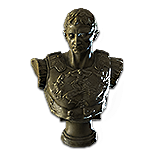
After Veruso's death, his successor was decided by the "Lord's Trial", an Azmerian tradition that had brought Veruso to power and would go on to inspire Izaro to build The Lord's Labyrinth. Caspiro, a "low-born legionnaire", was the only survivor of a "labyrinth" that had killed Veruso's only son, and was soon crowned Emperor Caspiro.[j]
Caspiro's reign was cut short, just 5 years after Veruso's death. He was "dismembered" by an unidentified entity known only as "a dark being".[k]
Azmerian writers of the time were "unified" in their description of a "portion of [their] Empire [being] cast into perpetual night", a "pervasive darkness" that enveloped what "would become the imperial heartlands". Wraeclastian historians are uncertain of the cause of these events", suggesting alternatives such as "peculiar weather patterns" or "thaumaturgical residue".[l]
The "pervasive darkness" that Alano Phrecia drove away is "likely" the same darkness that the exile releases in the Vaal Ruins near the Forest Encampment. The Vaal Oversoul was merely a construct built to house that darkness, like a massive totem. The exile breaks that seal in the Vaal Ruins near the Forest Encampment. Later, the Apex is used in a Vaal temple to summon the darkness into the Vaal Oversoul's mechanical body so that it can be destroyed.[41]
Reign of Alano Phrecia
General Alano Phrecia avenged the death of the emperor, defeating the "dark being", dispelling the darkness and returning "the gaze of Solaris" to the "lands stretching from the foot of the Mantle to the Axiom Ranges". For this victory, the "Imperial heartlands" were named in his honour - land that translates the historical Phrecia Cathedral and the modern-day Fellshrine Ruins.
"... our legions drove the dark being deep into the recesses of its lair and sealed it away for eternity"
- Alano Phrecia, first Sacrato of Lurici, 35 I.C., on defeating the "dark being".
In the absence of a clear Veruso succession, Alano Phrecia was crowned emperor, beginning an "unbroken line of Phrecia emperors" that ended with Izaro.
Reign of Romira Phrecian
The Empress, Emperor Romira's wife, gave birth to two sons, whose father was Romira's brother. In "an act of vengeance", Romira held a banquet in which he fed her two sons back to her.[m]
Night of a Thousand Ribbons
The cannibalism and incest of Romira and his family brought great shame onto his subjects.[n][o]
In protest of the Emperor's activities, Sarn was burned to the ground[p] and Romira was desposed.[q] This event is known as the Night of a Thousand Ribbons; after Sarn's reconstruction, royals of the Eternal Empire would continue to hold festivities celebrating this event on the same day.[r] This event is notable for being the celebration during which Emperor Chitus was betrayed and murdered assassinated by Mayor Ondar during the Purity Rebellion.
Reign of Izaro
Emperor Izaro Phrecius was the last Phrecian emperor of the Eternal Empire. Decades of incest and inbreeding had rendered him impotent. Unable to produce an heir, he turned to a "forgotten tome on a forgotten shelf" of the Sarn Library to decide his successor - a tome entitled 'Ancient Traditions of Azmerian Ascendancy'.[s]
Izaro was inspired by the "Lord's Trial", a "rough-hewn maze festooned with wild animals and brutal traps" created by the Azmeri to determine their "chieftans". Tarkus Veruso himself, the "Prima Imperialus", was tested by one of these "trials" to a become the leader of the Azmeri. [t].
Izaro saw himself not as a man, but as a divine saviour trapped in a man's body.
-
Izaro's DilemmaIzaro's Dilemma
Imperial ClawClaw
Physical Damage: (81-90) to (207-230)
Critical Strike Chance: 6.00%
Attacks per Second: (1.76-1.84)
Weapon Range: 1.1 metresRequires Level 68, 131 Dex, 95 IntGrants 46 Life per Enemy Hit(80-100)% increased Physical Damage
Adds 20 to 50 Physical Damage
(10-15)% increased Attack Speed
+(300-400) to Accuracy Rating
100% increased Global Physical Damage while FrozenIzaro saw himself not as a man,
but as a divine saviour trapped in a man's body.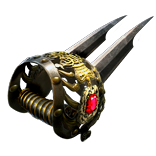
Inspired by the Lord's Trial, Izaro built The Lord's Labyrinth as a way to allow The Goddess of Justice to choose his successor. Izaro's labyrinth involved traps such as lava and "boobytrapped decoys", the latter of which killed a trapbuilder, Xirgil, in an accident during its construction.[u][v]
The High Gardens of Sarn were built by Izaro as a "test run" for the labyrinth, filling it with all sorts of "traps" and "nasty beasties". Convicted criminals were given a choice: Death, or going through the Garden. If they survived, they would be granted an imperial pardon. According to Hargan, no criminals ever made it through.[w]
Perandus conspiracy
Unbeknownst to Izaro, "treachery" was already growing in his own court,[x] primarily in the Perandus family. The Perandus family, especially Chitus Perandus, son of Julius Perandus, and his uncle Cadiro Perandus, resented Izaro and his Phrecian bloodline for having blocked their family's claims to the throne on the basis of their bloodlines. Cadiro saw the labyrinth as his family's "only clear shot" at "sovereignty".[y]
Perandus gold has filled the imperial coffers.
Perandus minds have crafted this Empire into the marvel it is today.
And has a single Perandus ever sat upon the imperial throne? No.
- Chitus Perandus, Letters from Chitus, Letter 1
Three letters, sent by Chitus to his uncle, Cadiro, on the 3rd Kaso of Vitali, 1316 I.C., 1st Lunaro of Verusi 1317, I.C., 3rd Solaro of Divini, 1318 I.C., are known as the Letters from Chitus. These letters detail Chitus' plans to sabotage Izaro's plans for the Labyrinth and take the throne for himself.
In the first letter, Chitus expresses his dissatisfaction with Izaro's plans for the Labyrinth, believing that the Perandus family deserved the imperial throne far more than any "peasant or peon" emboldened by the opportunity.
In the second letter, Chitus describes three failed assassination attempts on Izaro's life, each time "astutely thwarted" by Izaro's men. Cousin Elano, an illegitimate member of the Perandus family, was executed as part of the failed assassination attempts to prevent any "inconvenient disclosure". Giving up the plans for assassination, Chitus turned to winning the Labyrinth for himself. Using the vast resources of the Perandus family, Chitus "purchased" several of Izaro's overseers, familiarizing himself with the Labyrinth's architectural plans.
In the third letter, Chitus describes training heavily with the duelist Kre Faarblood, a great swordsman of Sarn, only to have Faarblood tried and executed after Faarblood revealed that he was not the "noble blood" that he had claimed to be. He describes Izaro's various "hazards and living horrors", describing spikes that "pop out of the floor", spin on "shifting wheels", and roam about like "predators in search of prey", revealed to him by his bought overseers. Chitus arranged "hirelings" to place "discrete caches of supplies" scattered throughout the Labyrinth to support him during the trial, and concluded with a list of their names to Cadiro to have them executed.
In these plans, Chitus was "aided immeasurably" by his uncle, Cadiro.[42]
The Lord's Labyrinth
On the second Galvano of Azmeri, 1317 IC, Izaro opened The Lord's Labyrinth. To commemorate the occasion, Izaro had the remains of the first claimant", "the first to challenge its treacherous traps", gilded in gold.[z] Among the first challengers were "The Son of Sarn", Chitus Perandus, and Weylin, an Ezomyte slave, "The Son of Ezomyr". Their journey through the labyrinth is recounted by poem environmental lore objects encountered in the labyrinth.
Chitus and Weylin helped each other through the labyrinth. Chitus was as the "Guide", directing them through dangerous traps and mazes, using his bought knowledge of shortcuts, tricks, and cached supplies to give them an unfair advantage. Weylin was the "Warrior", using his superior combat abilities to slay "beast and fiend". Weylin had entered the labyrinth with hopes of becoming emperor and freeing his people, the Ezomytes, of their subjugation under the Eternal Empire. To gain his trust, Chitus told him that he had similar plans, despite having no such intentions whatsoever. At one point, Weylin was badly injured and near death, and Chitus used one of his secrets to save Weylin's life. At another, Chitus was cornered by "slavering beasts", but was saved when Weylin "struck [them] down".
Near the end of the Labyrinth, Chitus betrayed Weylin by offering him a poisoned "flask". Weylin drank of it and died, allowing Chitus to exit the Labyrinth and "ascend" as the next Eternal Emperor.
Reign of Chitus
On the first Kaso of Verusi, 1319 IC, Chitus was crowned Emperor of the Eternal Empire.[43]As emperor, his first action was to seal Izaro into the Lord's Labyrinth, trapping him in his own creation, in which he stayed until his death.[aa] The exile can still encounter Izaro as an enemy in The Lord's Labyrinth.
Emperor Chitus was a brutal and charismatic leader[ab] as vain as Atziri,[ac] who expanded his empire into neighbouring nations "at a great human cost".[ad] Chitus' rule was heavily influenced by his "Laureate Thaumaturge", the "Father of Dreams", Malachai.[ae] In a Letter to Chitus, Malachai campaigned for the the formation of a "Thaumatocracy", or the integration of virtue gems and thaumaturgy into Eternal society.
Slave trade
During Chitus' reign, the Eternal Empire enslaved the Karui, Ezomyte, and Maraketh.[af] Prominent members of the slave trade included Captain Sigmund Fairgraves, who shipped "Karui children" across the seas; Marceus Lioneye, who launched campaigns against the Karui and enslaved those he conquered; and brutal Ezomyte slavemaster Gaius Sentari.[ag][ah][ai] The Marketplace was used a market for the Karui slave trade.[aj]
The bulk of slaves were to sent to "civilization camps" run by Gaius Sentari near Highgate. There, Malachai tasked them with the job of mining for and excavating the virtue gems that had been buried there by Tarcus Veruso. To further facilitate their ability to mine for gems, Malachai used them as test subjects on which he experimented with bodily transfiguration. Limbs were "stretched, contorted, double and triple jointed", and their eyes were "injected with gloom", which, in exchange for better night vision, forced them to squint and cower in the sun.[ak] At some point, the entrance to the mines were sealed, and those remaining were left to die.[al] The humanoid monsters encountered by the exile in The Mines Level 1, The Mines Level 2, and The Crystal Vein, such as Pocked Miner, Pocked Goliath, and Tunneler may be those same miners, kept alive by the thaumaturgy of the Cataclysm.
The slaves also mined for Voltaxic Sulphite and Thaumetic Sulphite.[am] The exile can Delve for Voltaxic Sulphite in the Azurite Mines, also located under the mountains of Highgate. Some of the mined Thaumetic Sulphite, a hazardous substance that "fevered the blood" and "scorched the mind" of its slave handlers,[an] was carried to a refinery near The Docks, some of which is later found by the exile as part of the Act 3 quest ![]() Fiery Dust.[ao]
Fiery Dust.[ao]
Besides working in the mines, after being sold and auctioned off in markets, slaves were sent to work in mills and into the streets of Sarn, where they were regularly flogged and overworked to their deaths. Those who resisted were subject to being skinned and butchered.[ap]
Malachai
Malachai drew upon the work of Lazhwar, an old archbishop of the Eternal Faith, who had experimented with thaumaturgy and discovered maps to create the Eternal Laboratory.[aq][ar] He called Icius Perandus to his laboratory to help translate some "artefacts", possibly the Golden Pages, which described the events of the Vaal Cataclysm.[as] Inspired, he built the Reverie Device, a precursor to the Map Device. He began inserting maps into it travelling into the "Nightmare".[at]
After touching and interacting with gems, Malachai began having thaumaturgy-related dreams. In them, the Beast spoke to him, and began teaching him "lessons cloaked in Nightmare". He began working in a similar to purpose to Doryani of the Vaal, who Malachai described as one who "knew the truth". The truth to what, is uncertain.[au]
Malachai began on the quest to create "the ideal gemling", a synthesis of human flesh and virtue gems.[av] Volunteers were called forward to become the subjects of Malachai's experiments, where he attempted to "unlock the raw power hidden within Virtue Gems".[aw]
Seeking "otherworldly inspiration", Malachai was known to consume a substance known as 'Ghost Wine'. For that purpose, he created the ![]() Decanter SpiritusDecanter Spiritus"Man is blinded by the mud of his corporeal self. Only
Decanter SpiritusDecanter Spiritus"Man is blinded by the mud of his corporeal self. Only
through the transformation of the material into the
spiritual can we hope to taste the full body of life."
- Malachai the Soulless![]() , later found by Captain Fairgraves and left by him in The Marketplace, where the exile finds it as part of the quest
, later found by Captain Fairgraves and left by him in The Marketplace, where the exile finds it as part of the quest ![]() A Swig of Hope.[ax]
A Swig of Hope.[ax]
Malachai created the institution of Gemling legionnaires, armies of the Eternal Empire led by a Captain and composed of men infused with virtue gems, not unlike the exile themselves.[ay] Gemlings, empowered by gems, were far more powerful than any contemporary human opponents and gave the Eternal Empire militaristic dominance over its enemies. As a failsafe, to prevent the gemlings from turning on him, Chitus received a large gem embedded into his chest, connecting the beating of his own heart to that of each legionnaire. If Chitus was to die, the gemlings would die also.[az]
Dialla was originally a concubine of Malachai's, among many others in the Sceptre of God.[ba] She talked too much, "asked too many difficult questions", and was given to Malachai.[bb] They fell in love, and Malachai promised Dialla that she would become his Gemling Queen.[bc]
Maligaro
Maligaro was one of the The Godless Three, a group of thaumaturgists who studied under Malachai: Shavronne, himself, and Doedre. Shavronne devoted herself to the "study of transfiguration", and, obsessed with eternal beauty, was notorious for her vanity.[bd][be] Doedre, known as Doedre Darktongue, was obsessed with "the meat" (human flesh) and is heavily associated with hexes and curses.[bf][bg] Maligaro, known as Inquisitor Maligaro, was a creative; however, he worked with flesh and blood instead of canvas and ink.[bh]
The Chamber of Sins, so named by Archbishop Geofri to express his contempt for it and its master, was built by Emperor Chitus as a laboratory in which Maligaro conducted his experiments.[bi] The unholiness of the Chamber of Sins was opposed by the nearby Phrecia Cathedral, modern day Fellshrine Ruins.[bj]
Maligaro studied virtue gems, working in parallel with Malachai. For this purpose, he built ![]() Maligaro's SpikeMaligaro's SpikeMaligaro loved his tools, and took great
Maligaro's SpikeMaligaro's SpikeMaligaro loved his tools, and took great
pains to keep them excruciatingly sharp.![]() . The Spike's purpose was to inject "Calibric Extantia", or the "corrupt energies locked within virtue gems", into human flesh. Malachai gifted the Transmutia Device to Maligaro in an effort to support his experiments.[bk] Later, the exile encounters this device in The Chamber of Sins Level 2 (Act 2). With the assistance of Helena, they transfer it to the exile's hideout and use it as the crafting bench.[bl][bm][bn]
. The Spike's purpose was to inject "Calibric Extantia", or the "corrupt energies locked within virtue gems", into human flesh. Malachai gifted the Transmutia Device to Maligaro in an effort to support his experiments.[bk] Later, the exile encounters this device in The Chamber of Sins Level 2 (Act 2). With the assistance of Helena, they transfer it to the exile's hideout and use it as the crafting bench.[bl][bm][bn]
Besides humans, Maligaro also experimented with rhoas.[bo] While many of the subjects were not willing, one was: Raulo. Raulo was an assistant who offered himself up as a willing test subject to be injected with "Calibric Extantia" by ![]() Maligaro's SpikeMaligaro's SpikeMaligaro loved his tools, and took great
Maligaro's SpikeMaligaro's SpikeMaligaro loved his tools, and took great
pains to keep them excruciatingly sharp.![]() . He and Maligaro entered a romantic, and possibly abusive homosexual relationship.[bp][bq] Maligaro injected Raulo using Maligaro's Spike, granting him "endless life and horrific deformity". In honour of his sacrifice, Maligaro renamed him Fidelitas, Latin for faithfulness or fidelity.[br]
. He and Maligaro entered a romantic, and possibly abusive homosexual relationship.[bp][bq] Maligaro injected Raulo using Maligaro's Spike, granting him "endless life and horrific deformity". In honour of his sacrifice, Maligaro renamed him Fidelitas, Latin for faithfulness or fidelity.[br]
The ![]() Baleful GemBaleful GemThe withering glare of corruption, made
Baleful GemBaleful GemThe withering glare of corruption, made
corporeal and pellucid in crystal.![]() was created by Maligaro as a byproduct of his efforts to "enhance" the abilities of virtue gems. By taking it and combining it with the venom,
was created by Maligaro as a byproduct of his efforts to "enhance" the abilities of virtue gems. By taking it and combining it with the venom, ![]() Black VenomBlack Venom"The spider is not defined by how
Black VenomBlack Venom"The spider is not defined by how
it lives, but by how it kills."
- Inquisitor Maligaro![]() , extracted from the Weaver, Maligaro created a substance known as "Black Elixir", proclaiming it to be "the most potent poison in existence".[bs]
, extracted from the Weaver, Maligaro created a substance known as "Black Elixir", proclaiming it to be "the most potent poison in existence".[bs]
The Purity Rebellion
The Purity Rebellion was an uprising led by High Templar Voll, who believed that gems and thaumaturgy were a "perversion" to the Empire.[bt]. He sought to overthrow Chitus, execute Malachai, outlaw thaumaturgy, and "purify" his empire. He was supported by Sarn poet and art critic, Victario Nevalius, who had grown disillusioned with Chitus' reign and thaumaturgy as a whole.
Bloody Flowers Rebellion (Derevi, 1333 IC)
Thane Rigwald of the Ezomytes killed reigning King Skothe and became the new king.[bu] He criticized Skothe for his complacency and indulgence in his kingship while the common Ezomyte people were being oppressed and enslaved by the Eternals, and not moving to rebel against or fight them.[bv][bw]
To enlist Rigwald's help in the rebellion, Voll tasked Victario to write him letters, hoping that the poet's words would be more effective than any politician.[bx][by] He was right, and Rigwald began planning a rebellion. Not permitted to possess weapons, the Ezomytes had been training in secret for years.[bz]
On the 3rd Fiero of Dirivi 1333 IC, the Ezomytes rose to rebellion against Governor Gaius Sentari in the fields of Glarryn. So colourful were the thousand tartans and banners raised that the uprising became known as "The Bloody Flowers Rebellion". Though Sentari's Gemlings killed three Ezomytes for each one of their own that fell, the "Bloody Flowers" reached victory through "sheer fury-driven courage". The clans of Ezomyr, before divided, were brought together by the common enemy of the Empire after the victory at Glarryn.[ca]
"Today, clansmen, my sword is my voice!"
- Rigwald, at the Battle of Glarryn[cb]
After the defeat, Sentari fled to Sarn,[cc] only to return in Astrali with reinforcements drawn from the capital, Vastiri and southern garrisons. The weakening of forces in those areas was part of Voll's plan, as they set up the future attack on Lioneye's Watch in the south, the Maraketh ambush in the Vastiri Desert, and the final siege of Sarn.
Lioneye's Watch[cd]

Accompanied by Victario, Voll visited King Kaom of the Karui in Ngamakanui, hoping to secure his assistance for the Purity Rebellion. On their arrival, they observed Kaom defeat Akoya in ritualistic combat for leadership of the Karui. With Kaom was his advisor Lavianga and his niece Hyrri. Despite viewing the Karui Way as "savagery",[ce] Voll needed the Karui to attack the southernmost Eternal Legion, stationed at Lioneye's Watch and commanded by General Marceus Lioneye.[cf] In exchange for his support, Voll promised Kaom sovereignty over his conquered lands on Wraeclast's south shore and freedom for the existing Karui slaves.[cg][ch] Lioneye, an archer who had one of his eyes replaced with a "golden-hued" gem, would be a formidable foe for Kaom.[ci][cj] At the feast table, Voll warned Kaom of the archery ability of Lioneye and his Gemling soldiers, suggesting to him that he too adopt archers. Enraged, Kaom responded that archers were forbidden by Karui tavukai, which forbade men from using long-ranged attacks like bows. That night, Voll set sail to meet Sekhema Deshret to negotiate the return of the Vastiri Plains in exchange for the support of the Maraketh.[ck]
"When eye meets eye, axe meets axe,
the remembered will walk the way unto the ancestors."
- King Kaom, to Emperor Voll[cl]
Sailing under the cover of night on Wraeclast's South Shore, Kaom planned to use the element of surprise to defeat Lioneye. Landing on the Coast, Kaom's men were quickly detected by camps of legionnaires, who lit signal fires and alerted Lioneye of the attack.[cm] Lioneye fired volleys of incendiary arrows onto the Karui and their canoes, removing their element of surprise[cn], and cutting off their escape. As the Karui retreated, Lioneye ordered his men forwards, trying to catch them before their escape. Cognizant of Karui tradition forbidding men from weapons like bows, Lioneye and his men discarded their shields, believing them to be unnecessary and hindering their movement.[co] Lioneye and his Gemling Legion, empowered by virtue gems, would have slaughtered Kaom's men like "pigs in a pen" in a man-to-man fight on open ground.[cp]However, Lioneye and his men were surprised by a battalion of female archers, among them Hyrri,[cq] who appeared over a cliff and hailed arrows over the defenceless Eternals. They had travelled to Thebrus and learnt archery with Voll's "finest military tutors".[cr]Enraged, Kaom attacked Victario, the originator of the archery plan, who rebutted that the archers were all women, and not men, satisfying tradition.
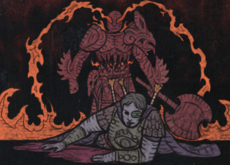
"It is dishonour for a man to kill another man from a distance."
Gaining the upper hand, Kaom attacked Lioneye and severed his arm. Lioneye pleaded to Kaom that he spare the women and children,[cu] but Kaom refused, executing Lioneye and slaughtering all of the Eternals present at the camp.[cv][cw] Upon killing Lioneye, Kaom "honoured" him by placing his decapitated head on his belt, ![]() HeadhunterHeadhunter
HeadhunterHeadhunter
Leather BeltRequires Level 40+(25-40) to maximum Life+(40-55) to Strength
+(40-55) to Dexterity
+(50-60) to maximum Life
(20-30)% increased Damage with Hits against Rare monsters
When you Kill a Rare monster, you gain its Modifiers for 60 seconds"A man's soul rules from a cavern of bone, learns and
judges through flesh-born windows. The heart is meat.
The head is where the Man is."
- Lavianga, Advisor to Kaom![]() .[cx] The discarding of their shields was the primary factor that led to the downfall of Lioneye and his men.[cy][cz]
.[cx] The discarding of their shields was the primary factor that led to the downfall of Lioneye and his men.[cy][cz]
Axiom Prison
Kaom's victory at Lioneye's Watch secured a safe harbour for landing reinforcements and established the first ever Karui settlement on the Wraeclastian mainland.[da][db] He set his sights up north, and began advancing towards Sarn.
The next Eternal outpost in his path was the Axiom Prison, currently inhabited by its warden, Brutus; Shavronne of Umbra,[dc] resident thaumaturge; and Kadavrus, assistant to Shavronne. Brutus and Shavronne prepared themselves for the Karui attack.[dd][de] Brutus allowed Shavronne to use him as a test subject" for her thaumaturgy to "transform" Brutus, in a "mad attempt at immortality".[df][dg] Brutus, turning mad, killed Shavronne and the other residents of the prison.[dh] The Karui, despite never having defeated Brutus, were able to reach as far as the Ship Graveyard, possibly through going around the coast by canoe.[di] In the area past the Axiom Prison, Prisoner's Gate, Shavronne created a thaumaturgical "barricade" to cut off the pass to the Western Forest.[dj] Although it is unknown if Shavronne herself ever activated it, Piety actives this barrier in Act 1 when the exile approaches it in Prisoner's Gate to cut them off. Later, as part of the quest ![]() The Way Forward in Act 2, the exile retrieves the
The Way Forward in Act 2, the exile retrieves the ![]() Thaumetic EmblemThaumetic EmblemA sigil of thaumaturgy graven in granite.
Thaumetic EmblemThaumetic EmblemA sigil of thaumaturgy graven in granite.![]() from Captain Arteri and reopens the passage, paving the way for Act 6.
from Captain Arteri and reopens the passage, paving the way for Act 6.
At an unknown point in time, the Karui settlements at Lioneye's Watch had been plagued by a "black spirit", resulting in social unrest[dk], raising of undead[dl], and twising of the wildlife.[dm] Taking his 500 "mightiest warriors", Kaom marched onto Highgate, led on by what he though was the voice of Tukohama, Karui god of War, but was really the voice of Malachai. He sought to lead the Karui "back to glory" and "wage war on Kitava, whom he blamed for the Karui's troubles on Wraeclast.[dn] The remaining Karui were led back to Ngamakanui by Hyrri on canoe.[do] Reaching Highgate without losing a single man, he was deceived by the Beast into slaughtering each of the 500 Karui he had brought with him, believing them to be "corrupted" by Kitava and the soil of Wraeclast.[dp][dq][44] The Beast "devour[ed] his very life force", consuming him and making him a part of itself.[45] The timeline for these events are unclear, but he reached Highgate about twenty years before Deshret created Deshret's Seal and sealed the entrance to the Mines.[dr] He ended up trapped in The Caldera of the King arena in Kaom's Stronghold.[ds]
Defeat of Titucius (Vitali, 1333 IC)

General Hector Titucius, Ezomyte by birth, was an Eternal commander who had his joints replaced with virtue gems.[dt][du] Known as the "Scourge of the Maraketh", he had previous killed Sekhema Asenath of the Maraketh and taken their highest symbol of office, the ![]() Wings of VastiriWings of VastiriAnd mounting her mighty Roc, Garukhan, holy queen of the sky,
Wings of VastiriWings of VastiriAnd mounting her mighty Roc, Garukhan, holy queen of the sky,
descended upon her enemies and their armies of darkness.![]() .[dv] Later, the exile retrieves the wings from an undead Titucius in the Bath House for Hargan in the quest
.[dv] Later, the exile retrieves the wings from an undead Titucius in the Bath House for Hargan in the quest ![]() The Wings of Vastiri.
The Wings of Vastiri.
The information from the following military sequence is taken from Garivaldi's "The Purity Chronicles", "Book 4: The Red Sekhema's Saddle".[dw]
In exchange for her military support in the rebellion, Voll promised Sekhema Deshret, the Red Sekhema, the return of the Vastiri Plains to the Maraketh. She agreed on the condition that she have Hector Titucius' skin with which to fashion a rhoa's saddle. He agreed.
To this end, Deshret and her akhara (Maraketh for tribe) set a trap for Titucius and his Vastiri Legion using their knowledge of their environment. They had long been recording the comings and goings of "viscous" dust storms that ravaged the Vastiri Plains, and could predict one such storm within a day's march from Titucius' camp. To lure them there, Voll identified a number of Eternal spies within the Maraketh and fed them false information regarding a potential "tribal uprising".
On the third Galvano of Vitali 1333 IC, the desert storm and Deshret's akhara descended upon and completely destroyed Titucius and his Legion. Deshret claimed her prize, and it was said that there was "no more comfortable saddle in all of Vastiri than Deshret's".
Death of Geofri
In 1332 IC, one year after Kaom's victory at Lioneye's Watch, Victario arrived at The Chamber of Sins in a carriage with Lady Dialla and Malachai. After being greeted by Maligaro, whom Victario remarked had gems implanted in his head, and his slave and assistant Raulo, they entered and observed the young Black Death, its venom, and the ![]() Baleful GemBaleful GemThe withering glare of corruption, made
Baleful GemBaleful GemThe withering glare of corruption, made
corporeal and pellucid in crystal.![]() . Raulo mentioned that combining the venom with the gem would create the "Black Elixir", a poison "strong enough to kill even the most powerful gemling".[dx][dy] The guests observed Maligaro transform Raulo into Fidelitas with
. Raulo mentioned that combining the venom with the gem would create the "Black Elixir", a poison "strong enough to kill even the most powerful gemling".[dx][dy] The guests observed Maligaro transform Raulo into Fidelitas with ![]() Maligaro's SpikeMaligaro's SpikeMaligaro loved his tools, and took great
Maligaro's SpikeMaligaro's SpikeMaligaro loved his tools, and took great
pains to keep them excruciatingly sharp.![]() . Malachai told Maligaro that he would soon give him the Transmutia Device, which he claimed would allow him to "directly manipulate the intelligence that dwells within virtue gems."[dz]
. Malachai told Maligaro that he would soon give him the Transmutia Device, which he claimed would allow him to "directly manipulate the intelligence that dwells within virtue gems."[dz]
Later that night, Victario snuck out to Phrecia Cathedral, using the code phrase "Death to Sin" and the sign of a templar descry on his palm to enter, indicating that he was a member of the Purity Rebellion. He came to Geofri, Archbishop of the Cathedral with warnings of the experiments occurring at the Chamber of Sins and of Maligaro's possession of the Transmutia Device. Sent by Geofri, Victario, along with a squadron of templars, returned to the Chamber of Sins and began demolishing Maligaro's documents and equipment,[46] making sure to pick up the Black Elixir for later. However, they were ambushed by Maligaro, his allies and his creations, who revealed to Victario that he had been under "thaumaturgical observation"[ea] since his arrival and began massacring the templars. Taking Victario prisoner, they moved on to Phrecia Cathedral. Geofri was slain at the foot of Corutino's shrine, a shrine dedicated to Saint Corutino the Golden Hand, with Maligaro's Etcher. Archbishop Geofri later reanimated as an undead guardian, who is later encountered by the exile guarding the ![]() Golden HandGolden HandAn open palm raised in peace,
Golden HandGolden HandAn open palm raised in peace,
cut down by the slaves of war.![]() in the Act 2 quest
in the Act 2 quest ![]() Through Sacred Ground.[41] In the chaos of the battle, Dialla, sympathetic to Victario's cause, freed him, asking him to cut her with a shard to broken glass to make it appear that he had overpowered her and escaped. Escaping through the Phrecian Forest, Victario left on boat for Sarn.
Through Sacred Ground.[41] In the chaos of the battle, Dialla, sympathetic to Victario's cause, freed him, asking him to cut her with a shard to broken glass to make it appear that he had overpowered her and escaped. Escaping through the Phrecian Forest, Victario left on boat for Sarn.
Siege of Sarn (Divini, 1334 IC)
On the way to lay siege to Sarn, Voll and his Army of Purity burned Maligaro and Doedre at the stake for, among other crimes, hereticy, torture, murder, and enslavement.[eb][ec][ed] Before his death, Maligaro created ![]() Maligaro's MapMaligaro's Map"Certain maps can only be rendered in the most vivid of viscera."
Maligaro's MapMaligaro's Map"Certain maps can only be rendered in the most vivid of viscera."
- Inquisitor Maligaro![]() , formed out of his own "viscera", which served to transfer his spirit into an "existential safe house" in Maligaro's Sanctum. Upon finding it, Geofri tried to destroy it, but failed and locked it away in the ruins of Phrecia Cathedral, modern day the Crypt under the Fellshrine Ruins (Act 7).[ee] In Act 7, it is there that the exile finds the map, goes to the Chamber of Sins Level 1 (Act 7), and uses it to finally defeat Maligaro in the quest
, formed out of his own "viscera", which served to transfer his spirit into an "existential safe house" in Maligaro's Sanctum. Upon finding it, Geofri tried to destroy it, but failed and locked it away in the ruins of Phrecia Cathedral, modern day the Crypt under the Fellshrine Ruins (Act 7).[ee] In Act 7, it is there that the exile finds the map, goes to the Chamber of Sins Level 1 (Act 7), and uses it to finally defeat Maligaro in the quest ![]() Essence of the Artist.
Essence of the Artist.
On the last day of Divini 1334 IC, High Templar Voll laid siege to Sarn, with the support of Ezomyte, Karui and Maraketh rebels under the respective leaderships of Thane Rigwald, Hyrri of Ngamakanui and Sekhema Deshret.[ef]
Battle at the Grain Gate
Returned to Sarn, Victario began work inciting the populace in rebellion. He began creating the Ancient Graffiti later encountered by the exile in The City of Sarn, The Slums, The Battlefront, The Docks, and The Ebony Barracks. Using the phrases "Monkey King" to refer to Emperor Chitus and "The Blackest Monkey" to refer to Malachai, the graffiti conveyed a highly critical view of the two and urged the Sarn population to revolt and "throw off" the Monkey King off of their "backs".[eg] Caught in the act of writing one of these graffiti by Sarn guards, Victario was saved by Marylene and a gang of rebels, who brought him to the underground Sarn rebel base hidden in the Sarn Sewers, where they attended to a romantic affair. The underground hideout was also where Victario kept his three stolen Platinum Busts, which the exile later retrieve for Hargan in the quest ![]() Victario's Secrets.[eh][ei]
Victario's Secrets.[eh][ei]
At the Sarn Arena, Malachai demonstrated the power of Gemling legionnaires to Lord Mayor Ondar. He watched with horror as a single Gemling defeated four Ezomyte slaves,[ej] convicted for having conspired in the Bloody Flowers Rebellion despite there being no evidence to back up such a claim.[ek] At the Warehouse District with Victario, Mayor Ondar recounted this story. After learning from Ondar of Chitus' plan to create an entire army of said Gemling legionnaires, Victario resolved to lead an uprising and dethrone Chitus. Ondar begged Victario to promise to spare Chitus' life, but Victario was unable to give him his word.
Victario's rebellion began. First, they spread information about secret storehouses of food that Chitus had been stashing away for his legionnaires. Starving families started riots and caused Chitus to send his legionnaires to defend the storehouses, diverting troops away from the rebels' true target - the Grain Gate Garrion, a place Victario had identified as the most weakened by the diversions. The Templars, under Voll, Ezomytes, under Thane Rigwald, Maraketh, under Sekhema Deshret, and Karui, under Hyrri marched upon the Grain Gate.[el]
Upon blasting open the Grain Gate, Victario's forces were met by a squadron of Gemling legionnaires, led by Emperor Chitus. Dialla, whom Malachai had adorned all over with gems, going so far as to implant them into her spine,[em][en] grabbed Victario and threw him against a wall, preparing to fire a blast and kill him. Marylene jumped inbetween them, saving Victario but sacrificing her life in the process. The forces of the Purity Rebellion were eventually pushed back by the Gemlings, Victario escaped, injured, and the attack on the Grain Gate was unsuccessful.[eo][ep]
Assassination of Chitus
In the Sarn Slums, Victario grieved over Marylene's grave. Ondar approached him, offering condolences and discussed Chitus's role in abetting Malachai. Victario became convinced that Chitus had to be killed for the rebellion to be successful. He led Ondar into the rebel sewers and showed him the Black Elixir he had took from The Chamber of Sins, a poison he claimed to be potent enough to kill even Chitus. He demonstrated its effects on a captive Gemling, killing him.[eq]
Soon later, Ondar met with Dialla, Malachai, and Chitus on the Sceptre of God, where he raised concerns to Chitus about the Gemling legionnaires rising up and betraying him. In response, Chitus revealed that he had had a master gem implanted in his chest that connected the heartbeats of every Gemling legionnaire to that of his own. Thus, if he were killed, they would fall too. In anticipation of an assassination of Chitus, Malachai sent Official Orders to Captain Alsarus and his legion, requesting that they gather at "the warehouse"[er] to that they would be "beyond the perimeter of his heart gem's influence". These gemlings survived, and are later encountered and killed in the Grain Gate by the exile for Maramoa in the quest ![]() The Gemling Legion.[es]
The Gemling Legion.[es]
"The heart of each soldier beats in time to the heart of his emperor."
During the celebration of the Night of a Thousand Ribbons, Victario ambushed the event, crying out "Death to Sin!"[eu]. The waiters tore off their masks, revealing themselves to be undercover rebels and drew arms. Ondar, who had had gems implanted in him for this event,[ev] betrayed Chitus and killed him, impaling him[ew] with a claw infused with the Black Elixir.[ex] Mortally wounded but kept alive with the power of thaumaturgy, Chitus, enraged, cut down Ondar with an axe.[ey] With the death of Chitus, the Gemling leonnaires fell, and Dialla and Malachai were captured.[ez] After Chitus' death, grieving legionnaires buried him in the Imperial Gardens and a plum tree was planted over his grave.[fa] The plums from that tree grew to be extremely poisonous, and the exile later retrieves one of these plums for Captain Fairgraves in the quest ![]() A Swig of Hope.
A Swig of Hope.
Faced with the siege of Sarn and uprisings led by Victario in the Slums, Docks, and Warehouse districts,[fb] Lord Cadiro Perandus met with Voll on the 1st Sacrato of Phreci, 1334 and negotiated Sarn's unconditional surrender. A week later, Voll of Thebrus was crowned Emperor of the Eternal Empire.[fc]
In the months leading up to the revolt, Cadiro organised "steady stream" of "unremarkable carts and wagons" leading out of the capital. By the time House Perandus fell, he had stolen the entirety of the kingdom's treasury and hidden it in "caches throughout the land". The outstanding debtors of the Perandus family, of which there were more than that of any other family in the Empire, were trapped by the power of Prospero in eternal servitude to Cadiro after their deaths to defend these stolen troves.[42][fd]
Reign of Voll (1334 - 1339 IC)
Crowned Emperor of the Eternal Empire, Voll, the "Emperor of Purity", set to destroying the Empire's virtue gems, executing its thaumaturgists, cleansing it of thaumaturgy, and destroying its "signature extravagances".[fe]
Although he was initially sentenced to death by "living conflagration" in the Crematorium, Malachai saved himself by promising Voll a permanent "end to thaumaturgy" in exchange for his life.[ff] Voll's decision to trust Malachai would become known as a fatal mistake that led to the Cataclysm, an event that brought an end to the Eternal Empire.[fg] For over a year, in the Solaris Temple, Malachai worked on the Rapture Device, a device he claimed would able kill the Beast, the origin of all thaumaturgy.[fh][fi] He completed the Rapture Device on the first Fiero of Eterni 1336 IC.[fj]
The following day, Malachai and Lady Dialla, accompagnied by Voll and his Highgate Legion, arrived at the mountains of Highgate.[fk] They set up the Rapture Device in its current location in the Crystal Veins. First, to power it, they used ![]() The Eye of FuryThe Eye of Fury"Fear becomes Hatred.
The Eye of FuryThe Eye of Fury"Fear becomes Hatred.
Hatred becomes Fury.
Thus is Man transformed
from Martyr to Maker."
- Malachai![]() and the
and the ![]() The Eye of DesireThe Eye of Desire"It is a cruel joke that
The Eye of DesireThe Eye of Desire"It is a cruel joke that
Man was born with more
Intent than Life."
- Malachai![]() , taken from King Kaom and Daresso respectively.[fl] Kaom had been lured to Highgate by the Beast/Malachai's voice disguised as Tukohama, but how or why Daresso reached Highgate is subject to speculation, even to Wraeclastian scholars.[fm] However, it is known that Daresso had left Sarn in search for a cure for Merveil's transformation into a siren at the hands of the
, taken from King Kaom and Daresso respectively.[fl] Kaom had been lured to Highgate by the Beast/Malachai's voice disguised as Tukohama, but how or why Daresso reached Highgate is subject to speculation, even to Wraeclastian scholars.[fm] However, it is known that Daresso had left Sarn in search for a cure for Merveil's transformation into a siren at the hands of the ![]() Star of WraeclastStar of Wraeclast
Star of WraeclastStar of Wraeclast
Ruby AmuletRequires Level 28+(20-30)% to Fire ResistanceGrants Level 10 Frostblink Skill
(30-50)% increased Cold Damage
+(10-15)% to all Elemental Resistances
60% increased Area of Effect of Hex Skills
You cannot be Cursed with Silence
Frostblink has 50% increased DurationCorrupted"I offer to you an eternal oath
that binds your heart to mine;
a bond that not even death will break.
Will you accept?"
- Daresso, to his beloved![]() .[fn]
.[fn]
Malachai's true purpose was to use the Rapture Device to tear a hole in the Belly of the Beast, allowing him to enter the Black Core and take control, giving himself absolute power over thaumaturgy and the ability to trigger the Cataclysm.[fo] Malachai planned to betray Dialla, and "break her heart" by telling her that she had to sacrifice herself to "fuel" the device.[fp] Before activating the Rapture Device, he wrote Malachai's Dedication, dedicating it to his deceased pupils Maligaro, Doedre, and Shavronne. At some point, he revived the three, and tasked them with guarding three vital organs he had left behind, ![]() Malachai's HeartMalachai's HeartMy heart forces blood through my veins.
Malachai's HeartMalachai's HeartMy heart forces blood through my veins.
But one who may bleed may die, and
death is no fitting end to genius.![]() ,
, ![]() Malachai's LungsMalachai's LungsMy lungs breathe the same air as
Malachai's LungsMalachai's LungsMy lungs breathe the same air as
the foolish and the weak. May I be
yet another step removed from them.![]() , and
, and ![]() Malachai's EntrailsMalachai's EntrailsMy organs tether me to mortality
Malachai's EntrailsMalachai's EntrailsMy organs tether me to mortality
like a chain. This chain holds me
from my true potential.![]() .[fq] These organs were the only objects that tethered Malachai to mortality, which the exile later takes advantage of when they collect the organs to access the Black Core and kill Malachai in the quests
.[fq] These organs were the only objects that tethered Malachai to mortality, which the exile later takes advantage of when they collect the organs to access the Black Core and kill Malachai in the quests ![]() Corpus Malachus and
Corpus Malachus and ![]() The Eternal Nightmare.[fr]
The Eternal Nightmare.[fr]
However, Dialla was too "selfish", and, despite Malachai's begging, she did not sacrifice her life and only a small rupture was created.[fs] To the confusion of many Wraeclastians, Dialla would remain alive for centuries, where the exile later encounters her in The Solaris Temple Level 2 as part of the Act 3 quest ![]() The Gemling Queen.[ft][fu] Malachai entered the Beast, and initiated the Cataclysm.
The Gemling Queen.[ft][fu] Malachai entered the Beast, and initiated the Cataclysm.
The Cataclysm (~1339 IC)
The Cataclysm brought an end to Voll's reign and the Eternal Empire as a whole. Due to the devasting nature of the event, first-person recollections and general sources discussing this event are scarce. For reasons unknown even to Wraeclastian scholars, the effects of the Cataclysm were mostly confined to the Wraeclastian landmass, notably not affecting the island of Oriath.[fv] While Wraeclast's flora and wildlife were spared from the worst effects of the Cataclysm, the animals and soil have experienced mutations and corruption.[fw][fx][fy] The appearance of water elementals and rock elementals may have been caused by the Cataclysm.[fz]
Humans experienced the rotting of living flesh, nightmarish visions, tentacles growing from one's body, and general madness.[ga][gb][gc][gd] Gemlings seemed to have been especially affected.[ge] In Sarn, the sun turned in to an "orb of blood", and the sky was thrown into darkness by a tempest that had descended from the Highgate. Within an hour, the capital had fallen. Victario was killed.[gf][gg] In Ngamakanui, they experienced the moon "turning crimson", fire raining from the sky, and the boiling of the sea.[gh] Tempests and plagues were also observed, although they eventually passed.[gi] The dead were reanimated.[gj] Gemlings and citizens of Sarn were transformed into the Undying, mindless monsters that could live for hundreds of years.[gk][gl][gm]
During the first moments of the Cataclysm, General Adus and his elite legionnaires sought refuge in the Highgate Refinery.[gn] Later, in Act 9, the exile encounters Adus there and kills him for the ![]() Trarthan PowderTrarthan Powder"Blow it all down! The emperor must have his gems, no matter the cost!"
Trarthan PowderTrarthan Powder"Blow it all down! The emperor must have his gems, no matter the cost!"![]() in the quest
in the quest ![]() Recurring Nightmare.
Recurring Nightmare.
Voll, horrified by his failure, escaped to the Dried Lake and wrote Voll's Confession, apologizing to his "Empire of Purity" for his folly and begging it to survive him. He and his undead legion stayed there for centuries, harassing and attacking the nearby Maraketh at Highgate.[go] Later, in Act 4, the exile encounters and kills Voll in the Dried Lake to acquire Deshret's Banner in the quest ![]() Breaking the Seal.
Breaking the Seal.
The year after the Cataclysm, Wraeclast suffered an especially harsh winter, killing many of its few survivors.[gp][gq]
Deshret's Seal
Twenty years after Kaom and his warriors descended into Highgate, Sekhema Deshret and her 'akhara', the Kiyato, seeking to end the source of the corruption.[gr] However, reaching the entrance to the Mines, she "faltered", and instead chose to seal the entrance shut.[gs] The entrance was sealed before all of the miners inside could evacuate, resulting in many having been trapped below.[gt] These miners were likely reanimated by corruption into the humanoid monsters encountered in the mines by the exile.
At one point, Voll killed Deshret herself and took from her the key to opening the seal, ![]() Deshret's BannerDeshret's BannerWhen the sun sets, the plains should be red.
Deshret's BannerDeshret's BannerWhen the sun sets, the plains should be red.![]() .[gu] Deshret's soul was later captured by the Godless Three and trapped in The Mines Level 2, where the exile later finds and rescues her in Act 9 in the quest
.[gu] Deshret's soul was later captured by the Godless Three and trapped in The Mines Level 2, where the exile later finds and rescues her in Act 9 in the quest ![]() An Indomitable Spirit.[gv]
An Indomitable Spirit.[gv]
Modern Times
The dates on Letters of Exile range from "1597 IC" to "1599 IC" and the Incursion trailer starts to count down from "1600 IC". This allows an estimate of some point during the campaign or endgame taking place during 1600 IC.
In the modern age, Wraeclast bears no major civilizations[47], just a few disorganised descendants of the Empire[48] and undead[49]. It also bears a number of people from Oriath island. Some were shipwrecked[50], but many were exiled for crimes minor or major.[51][52][53]
The "current" (before Act 3) High Templar is a man named Dominus[54], who controls the Blackguards[55] as well as the Order of the Templar. Templars are the theocracy of Oriath. He recently acquired an interest in the history of the empire(s) on Wraeclast.[56] Dominus works in a laboratory at the top of the tower known as the Sceptre of God[57], but his assistants General Gravicius[58][59] and Piety[60] gather information and resources. The Templars wandering in Wraeclast are mostly from Blackguard legion.
Gravicius set up a temporary barracks in Sarn, near Lunaris Temple, and seems to be responsible for seeking out the artifact known as the Twist[61] and perhaps the Ribbon Spool[62]. Piety was originally named Vinia[63], and worked as a thaumaturgist and prostitute[64] in Theopolis, Oriath. "Currently" (Act 1 to 3) she is more of an archaeologist, roaming Wraeclast investigating the works and techniques of the Empire's most famous thaumaturgists including Shavronne[65][66] and Maligaro[67], as well as trying to reproduce their experimental results for herself. Like Malachai, she implants Virtue Gems surgically[68], although judging by the detritus in the lowest floor of the Lunaris Temple, she has not yet reached Malachai's level of skill.
Oriath
Oriath is a small island off the south-east coast of Wraeclast[69]. Oriath as a nation is a theocracy ruled by the Order of the Templar, lead by the High Templar (Dominus at the start of the game). The Templar regime is considered by many to be a a theocratic dictatorship[70], as evidenced by its oppressive rule, strict enforcement of law and religion, and its large population of Karui slaves.
The capital of Oriath is Theopolis[71], and contains at least historical archives[72], duelling arenas[73], and the headquarters of the Ebony Legion[74]. According to the Research Journals, Vaal ruins exist near the city of Oriath, which contains a pyramid.[75][76]
It also contains the Court of Divine Temperance[77], where criminal are tried and prosecuted for all kinds of crimes, from violent crimes and expression of heretical beliefs to operating an establishment without a license. No matter the reason, many of these criminals are shipped off and exiled to Wraeclast.
In ancient times, Innocence and his followers were banished from the Azmeri mountains and sent to Oriath.[78] This may be when Oriath was first colonized. By the time of the Empire's fall on the mainland, Oriath was a well-established and prosperous nation.[79]
In the Phrecian Forest in the Inner Empire in Wraeclast, is the Fellshrine, the ruins of an old Templar cathedral.[80] So the Templars, which is the current theocracy of Oriath island, have a long-standing link to the mainland at Wraeclast. And obviously the past leader of Templars, the High Templar Voll had an interest in the Empire. (Read #The Purity Rebellion (1333 - 1st Sacrato of Phreci 1334) for details.)
The in-game area of Act 5 and Act 10 are all located on Oriath island, such as Oriath Docks, The Cathedral Rooftop, Oriath Square (The Ruined Square, The Ravaged Square), The Templar Courts (The Torched Courts), The Chamber of Innocence (The Desecrated Chambers), etc. Due to the proximity, presumably they are in fact with in the Oriath capital, Theopolis.
Oriath, the in-game town, was destroyed by Sirus in Conquerors of the Atlas epilogue storyline. The Siege of the Atlas storyline shows the epilogue of its events a year later: The Templar order was reduced to a number of splinter groups, Oriath was abandoned, and its survivors settled in the Karui Shores.
See also
Notes
- ↑ Eramir, "The Azmeri"
- ↑ Order of the Djinn, "Module Error: No results found for item using search term "item_name = Rusted Elder Scarab""
- ↑ Unknown, "Distant Mud Pit Memory"
- ↑ Cadiro Perandus, "The Perandus Family"
- ↑ Clarissa, "Emperor Veruso"
- ↑ Clarissa, "Emperor Veruso"
- ↑ Clarissa, "The Ankh of Eternity"
- ↑ Clarissa, "The Ankh of Eternity"
- ↑ Clarissa, on Tolman's second death
- ↑ Izaro Phrecius, "Bronze Inscription", IV
- ↑ Trinian, "The Ancients", "Book 7: The Light of Phrecia"
- ↑ Trinian, "The Ancients", "Book 7: The Light of Phrecia"
- ↑ Cadiro, on
 Romira's BanquetRomira's Banquet
Romira's BanquetRomira's Banquet
Diamond RingRequires Level 60(20-30)% increased Global Critical Strike Chance+333 to Accuracy Rating
+(15-25)% to Global Critical Strike Multiplier
+(40-60) to maximum Mana
0.4% of Physical Attack Damage Leeched as Mana
Gain a Power Charge on Non-Critical Strike
Lose all Power Charges on Critical StrikeThe Empress gave Romira two sons
Born of his brother's seed
Romira threw her a banquet
A perfidious meal indeed.
- ↑ Izaro Phrecius, Bronze Monograph, The Crematorium
- ↑ Izaro Phrecius, "Bronze Inscription", IV
- ↑
 Thousand RibbonsThousand Ribbons
Thousand RibbonsThousand Ribbons
Simple RobeEvasion: (30-60)
Energy Shield: (44-80)
Movement Speed: -3%Requires 17 IntSocketed Gems are Supported by Level 5 Elemental Proliferation
Adds (2-4) to (5-9) Fire Damage to Spells and Attacks
Adds (2-4) to (5-9) Cold Damage to Spells and Attacks
Adds 1 to (4-12) Lightning Damage to Spells and Attacks
+(30-60) to Evasion Rating
+(30-60) to maximum Energy Shield
+(25-50) to maximum Life
+(25-50) to maximum Mana
+(15-30)% to Fire Resistance
+(15-30)% to Cold Resistance
+(15-30)% to Lightning ResistanceThe night of a thousand ribbons
To remember the day of a thousand flames
When Sarn burned
And was born again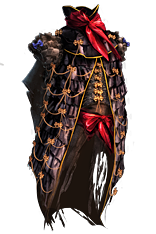
- ↑ Izaro Phrecius, "Bronze Monograph", The Crematorium
- ↑ Garivaldi, "The Purity Chronicles", "Book 5: The Emperor is dead. Long live the Emperor!"
- ↑ Izaro, Bronze Inscription, I
- ↑ Izaro, Bronze Inscription, II
- ↑
 Xirgil's CrankXirgil's Crank
Xirgil's CrankXirgil's Crank
Coiled StaffWarstaff
Physical Damage: 27-57
Critical Strike Chance: 6.20%
Attacks per Second: 1.30
Weapon Range: 1.3 metresRequires Level 28, 43 Str, 43 Int+20% Chance to Block Attack Damage while wielding a Staff+15% Chance to Block Attack Damage while wielding a Staff
(60-80)% increased Spell Damage
+(70-100) to maximum Energy Shield
+1 to Level of all Spell Skill Gems
Reflects 1 to 150 Lightning Damage to Melee Attackers
20% chance for Energy Shield Recharge to start when you Block"Since one with knowledge of machines
might be able to bring the labyrinth to a standstill,
Izaro had us place many boobytrapped decoys.
But I know which switch brings the monster down."
- Xirgil, Trapbuilder's final words.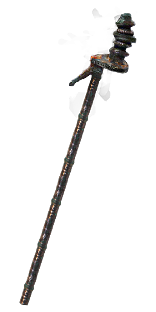
- ↑
 GlitterdiscGlitterdisc
GlitterdiscGlitterdisc
Burnished Spiked ShieldChance to Block: 26%
Evasion: (136-175)
Energy Shield: (72-110)
Movement Speed: -3%Requires Level 27, 37 Dex, 37 Int+5% chance to Suppress Spell Damage(120-140)% increased Evasion and Energy Shield
+(20-30) to maximum Energy Shield
+(30-50) to maximum Life
10% increased Rarity of Items found
25% chance to Avoid Fire Damage from Hits
You always Ignite while BurningIzaro's insistence on using lava
resulted in some surprising material discoveries.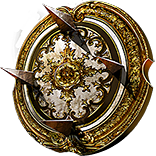
- ↑ Hargan, "The High Gardens"
- ↑
 Winds of ChangeWinds of Change
Winds of ChangeWinds of Change
Ancient GauntletsArmour: (154-173)Requires Level 47, 68 Str+(30-60) to maximum Life
30% increased Projectile Speed
(10-5)% reduced Movement Speed
10% chance to Knock Enemies Back on hit
(30-50)% increased Projectile DamageIzaro was slow to see the treachery growing in his own court
and powerless to stop it once he had;
a captain sailing his own ship into rocks.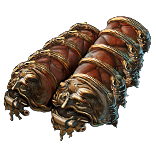
- ↑ Cadiro Perandus, "Izaro"
- ↑
 Spine of the First ClaimantSpine of the First Claimant
Spine of the First ClaimantSpine of the First Claimant
Iron SceptreSceptre
Physical Damage: (54-64.8) to (80-96)
Critical Strike Chance: 6.00%
Attacks per Second: (1.16-1.21)
Weapon Range: 1.1 metresRequires Level 20, 38 Str, 38 Int14% increased Elemental Damage(100-140)% increased Physical Damage
40% increased Damage with Hits against Frozen Enemies
+(25-35)% to Cold Damage over Time Multiplier
(30-50)% increased Cold Damage
(5-10)% increased Attack Speed
(4-8)% increased Cast Speed
5% chance to FreezeThousands gazed upon the doors of the great labyrinth,
at an Eternal Champion in steel and gold,
The first to challenge its treacherous traps.
To mark the occasion, Izaro had the Champion's remains gilded.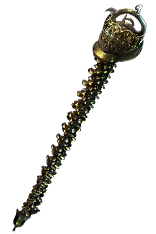
- ↑
 Izaro's TurmoilIzaro's Turmoil
Izaro's TurmoilIzaro's Turmoil
Crimson Jewel(18-25)% increased Fire Damage
(18-25)% increased Cold Damage
2% chance to Ignite
2% chance to FreezeThe once-glorious emperor spent his final days
imprisoned in his greatest creation;
a tool to filter out the unworthy
that pushed a monster to power.Place into an allocated Jewel Socket on the Passive Skill Tree. Right click to remove from the Socket.
- ↑
 Might and InfluenceMight and Influence
Might and InfluenceMight and Influence
Viridian JewelLimited to: 1
Radius: Medium(10-15)% increased Attack Damage
<Two random modifiers>Emperor Chitus could offer you a gift with one hand,
and drive a blade into your back with the other.
His blend of brutality and charisma cultured a potent
mixture of fear and admiration among the masses.Place into an allocated jewel socket on the Passive Skill Tree. Right click to remove from the Socket.
- ↑ Siosa, "Malachai"
- ↑
 Rapid ExpansionRapid Expansion
Rapid ExpansionRapid Expansion
Crimson JewelLimited to: 2
Radius: Medium(8-12)% increased Global Physical Damage
With at least 40 Strength in Radius, Ground Slam has a 35% chance
to grant an Endurance Charge when you Stun an Enemy
With at least 40 Strength in Radius, Ground Slam
has a 50% increased angleChitus began to aggressively expand his empire
into neighbouring nations at great human cost.
But for absolute power, there is no price
that a Perandus won't pay.Place into an allocated Jewel Socket on the Passive Skill Tree. Right click to remove from the Socket.
- ↑ Plaque (Sceptre of God)
- ↑ Dialla, "Thaumetic Sulphite"
- ↑ Victario, Victario's Writings, Volume 3: Slaves of Virtue
- ↑ Utula, "Slave Pens"
- ↑ Marauder, on killing Fairgraves
- ↑ Marauder, on The Marketplace
- ↑ Victario, Victario's Writings, Volume 3: Slaves of Virtue
- ↑ Unknown, "Abandoned Shaft Memory"
- ↑ Unknown, "Limestone Hollow Memory"
- ↑ Dialla uses the phrase "fevered the blood", which may refer to the "blood fever" suffered by the Karui when they come into contact with corruption, as described in
 HateforgeHateforge
HateforgeHateforge
Ancient GauntletsArmour: (338-432)Requires Level 72, 68 StrSocketed Gems are Supported by Level 30 Rage
(120-150)% increased Armour
(25-10)% reduced Rage Cost of Skills
Vaal Attack Skills you Use yourself Cost Rage instead of requiring Souls
You cannot gain Rage during Soul Gain PreventionThe first Karui born on the fringes of the Vaal empire developed a blood fever born of corruption.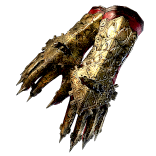 .
.
- ↑ Dialla, "Thaumetic Sulphite"
- ↑ Rigwald, "Inscription II"
- ↑ Cadiro, on
 Stone of LazhwarStone of Lazhwar
Stone of LazhwarStone of Lazhwar
Lapis AmuletRequires Level 5+(20-30) to Intelligence(12-15)% Chance to Block Spell Damage
(15-20)% increased Cast Speed
+(40-70) to maximum ManaYou are slow, foolish and ignorant.
I am not.
- ↑ Carl, "Supporter newsletter 4"
- ↑ Siosa,
 Golden Page (4 of 4)Golden Page"Siosa, your Slavery will cause them to overlook you.
Golden Page (4 of 4)Golden Page"Siosa, your Slavery will cause them to overlook you.
Your Karui Way will guide you.
Your Humanity will shame us all."
- Icius Perandus translation
translation
- ↑ Malachai, "Reverie Device"
- ↑ Malachai, Malachai's Journal
- ↑
 Collateral DamageCollateral Damage
Collateral DamageCollateral Damage
Viridian JewelLimited to: 2
Radius: Medium(10-15)% increased Global Physical Damage
With at least 40 Dexterity in Radius, Galvanic Arrow deals 50% increased Area Damage
With at least 40 Dexterity in Radius, Galvanic Arrow has 25% increased Area of EffectMalachai ran roughshod over every ethical boundary in pursuit of creating the ideal gemling.
For him, there was no doubt that the end would justify the means.Place into an allocated jewel socket on the Passive Skill Tree. Right click to remove from the Socket.
- ↑ Unknown, "Eternal Residence Memory"
- ↑ Captain Fairgraves, Decanter Spiritus
- ↑ Maramoa, "The Gemling Legion
- ↑ Path of Exile: Origins, Issue #4: The Black Heart, pg. 11
- ↑ Cadiro, on
 Dialla's MalefactionDialla's Malefaction
Dialla's MalefactionDialla's Malefaction
Sage's RobeEnergy Shield: (79-90)
Movement Speed: -3%Requires Level 37Gems can be Socketed in this Item ignoring Socket Colour
Gems Socketed in Red Sockets have +2 to Level
Gems Socketed in Green Sockets have +30% to Quality
Gems Socketed in Blue Sockets gain 100% increased Experience
Has no Attribute RequirementsHe took me by my hand, promised me power beyond compare.
But i did not do it for power.
I did it for love.
And I'd do it again in an instant.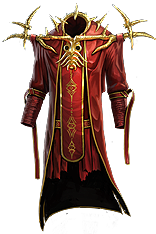
- ↑ Lady Dialla, "Malachai"
- ↑ Malachai, Journal Entry
- ↑ Helena, "Prisoner's Gate"
- ↑
 The Offering
The Offering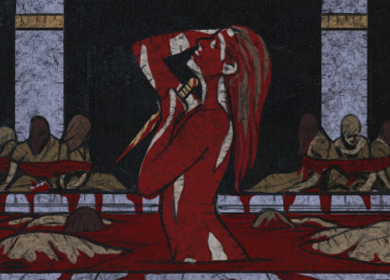 The Offering
The Offering 8
8 Shavronne's Wrappings
Shavronne's Wrappings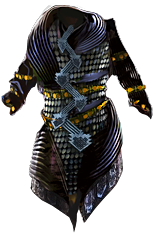 Eternal beauty has a cost, one which Shavronne was happy to pay with the lives of others.
Eternal beauty has a cost, one which Shavronne was happy to pay with the lives of others.
- ↑ Doedre, Doedre's Manifesto
- ↑
 Doedre's DamningDoedre's Damning
Doedre's DamningDoedre's Damning
Paua Ring+(20-30) to maximum Mana+(5-20) to Intelligence
+(5-20)% to all Elemental Resistances
Gain (5-20) Mana per Enemy Killed
You can apply an additional CurseWhere her mouth should have been there was only a whirling, black void. ,
,  Doedre's TongueDoedre's Tongue
Doedre's TongueDoedre's Tongue
Lapis AmuletRequires Level 24+(20-30) to Intelligence+(20-25)% to all Elemental Resistances
(20-25)% chance to Freeze, Shock and Ignite
Cursed Enemies cannot inflict Elemental Ailments on YouMaligaro did the cutting... at her request.
In the new void, a malevolent power emerged. ,
,  Doedre's ScornDoedre's Scorn
Doedre's ScornDoedre's Scorn
Lunaris CircletEnergy Shield: (141-168)Requires Level 39, 83 Int+2 to Level of Socketed Curse Gems
+(20-30) to Intelligence
+(100-120) to maximum Energy Shield
Adds 37 to 71 Chaos Damage for each Curse on the Enemy
Curse Skills have (30-50)% increased Skill Effect DurationA scar of the flesh you'll never forget,
A scar of the mind you'll never remember.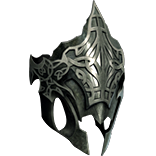 , and
, and  Doedre's SkinDoedre's Skin
Doedre's SkinDoedre's Skin
Widowsilk RobeEnergy Shield: (361-452)
Movement Speed: -3%Requires Level 65, 187 IntSocketed Gems are Supported by Level 20 Blasphemy
Grants Level 20 Summon Doedre's Effigy Skill
Socketed Hex Curse Skills are Triggered by Doedre's Effigy when Summoned
Hexes from Socketed Skills can apply 5 additional Curses
20% less Effect of Curses from Socketed Hex Skills
+(30-40) to Intelligence
(130-150)% increased Energy ShieldAs she was sentenced to death, Doedre was silent.
As she was tied to the stake, Doedre was silent.
As the flames licked away her life, Doedre was silent.
But Wraeclast had not heard the last of her.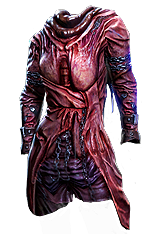 are examples.
are examples.
- ↑
 The Artist
The Artist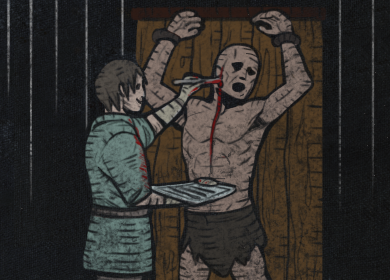 The Artist
The Artist 11Level 4 Enhance
11Level 4 Enhance
Corrupted"Paint, metal, flesh... A true artist does not limit himself." - Malachai the Soulless
- ↑ Eramir, "The Chamber of Sins"
- ↑
 The Balance of TerrorThe Balance of Terror
The Balance of TerrorThe Balance of Terror
Cobalt JewelLimited to: 1+(10-15)% to all Elemental Resistances
<2 random curse modifiers>Fellshrine stood as a holy bastion opposite the
Chamber of Sins, and all that it represented.
For one to rise, the other must fall.Place into an allocated Jewel Socket on the Passive Skill Tree. Right click to remove from the Socket.
- ↑ Malachai, "Transmutia Device"
- ↑ Helena, "Crafting"
- ↑ Helena, "Crafting Bench"
- ↑ Helena, "Transmutia Device"
- ↑
 The Rabid Rhoa
The Rabid Rhoa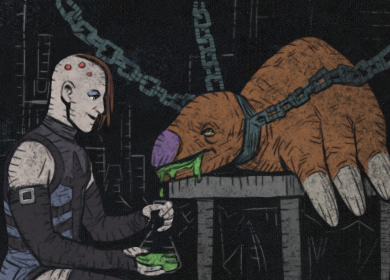 The Rabid Rhoa
The Rabid Rhoa 4Malicious Gemini Claw
4Malicious Gemini Claw
Item Level: 83"Experiment 22A: Rhoas, when deprived of water, secrete a most delightfully potent toxin."
- Maligaro
- ↑
 Fidelitas' SpikeFidelitas' Spike
Fidelitas' SpikeFidelitas' Spike
Jagged FoilOne Handed Sword
Elemental Damage: 1 to (40-50)
Critical Strike Chance: 5.50%
Attacks per Second: (2.00-2.08)
Weapon Range: 1.4 metresRequires Level 22, 77 Dex+25% to Global Critical Strike MultiplierNo Physical Damage
Adds 1 to (40-50) Lightning Damage
(25-30)% increased Attack Speed
Grants 2 Life per Enemy Hit
(15-20)% chance to Shock
Herald of Thunder has 50% increased Buff EffectMaligaro was transformed by Raulo's love.
Thaumaturgy allowed Maligaro to return the favour.
- ↑
 Echoes of MutationEchoes of MutationPerverse loyalty, blind love, the abuser and the abused reunited in sin.You will find the Echo of Maligaro in the Chamber of Sins and destroy it.Right-click to add this prophecy to your character.
Echoes of MutationEchoes of MutationPerverse loyalty, blind love, the abuser and the abused reunited in sin.You will find the Echo of Maligaro in the Chamber of Sins and destroy it.Right-click to add this prophecy to your character.
- ↑ Helena, "Fidelitas"
- ↑ Helena, "The Baleful Gem"
- ↑ Clarissa, "The Purity Rebellion"
- ↑ Rigwald, "Inscription I"
- ↑ Rigwald, "
 Deadhand TalismanDeadhand TalismanTalisman Tier: 1(19-31)% increased Chaos DamageCorruptedThe Empire poisons our blood with sweet wine.
Deadhand TalismanDeadhand TalismanTalisman Tier: 1(19-31)% increased Chaos DamageCorruptedThe Empire poisons our blood with sweet wine.
Poisons our flesh with silk.
Poisons our minds with civil lies.
Poisons our children with servitude.
- The Wolven King "
"
- ↑ Rigwald, "
 Spinefuse TalismanSpinefuse TalismanTalisman Tier: 3(6-10)% increased Quantity of Items foundCorruptedWe Ezomytes are beasts of burden
Spinefuse TalismanSpinefuse TalismanTalisman Tier: 3(6-10)% increased Quantity of Items foundCorruptedWe Ezomytes are beasts of burden
bearing wealth of an empire on our backs,
growing lean and strong
while our masters grow fat and weak.
- The Wolven King "
"
- ↑ Garivaldi, "The Purity Chronicles", "Book 2: Bloody Flowers"
- ↑ Grigor, "Victario"
- ↑ "The enslaved Ezomyte clans were not permitted to own weapons. For years, they trained in secret, watching and waiting for the perfect moment to reveal the true depth of the Empire's folly." - "Divide and Conquer", before it was renamed
 Seething FurySeething Fury
Seething FurySeething Fury
Viridian JewelLimited to: 1(10-15)% increased Attack Damage while holding a Shield
+0.15% to Off Hand Critical Strike Chance per 10 Maximum Energy Shield on Shield
+4% to Off Hand Critical Strike Multiplier per 10 Maximum Energy Shield on ShieldCorruptedIt took the Bloody Flowers Rebellion to show the clans of Ezomyr the truth;
What kept them apart was just a fabrication.
Conjured rivalries from men who grew fat from the discord they sowed.Place into an allocated Jewel Socket on the Passive Skill Tree. Right click to remove from the Socket. .
.
- ↑
 Seething FurySeething Fury
Seething FurySeething Fury
Viridian JewelLimited to: 1(10-15)% increased Attack Damage while holding a Shield
+0.15% to Off Hand Critical Strike Chance per 10 Maximum Energy Shield on Shield
+4% to Off Hand Critical Strike Multiplier per 10 Maximum Energy Shield on ShieldCorruptedIt took the Bloody Flowers Rebellion to show the clans of Ezomyr the truth;
What kept them apart was just a fabrication.
Conjured rivalries from men who grew fat from the discord they sowed.Place into an allocated Jewel Socket on the Passive Skill Tree. Right click to remove from the Socket.
- ↑
 Rigwald's ChargeRigwald's Charge
Rigwald's ChargeRigwald's Charge
Highland BladeTwo Hand Sword
Physical Damage: (99-112.5) to (184.8-210)
Critical Strike Chance: 5.00%
Attacks per Second: 1.62
Weapon Range: 1.3 metresRequires Level 44, 77 Str, 77 Dex+305 to Accuracy Rating(120-150)% increased Physical Damage
20% increased Attack Speed
10% increased Movement Speed
+(300-350) to Accuracy Rating
15% increased Movement Speed if you've Killed Recently"Today, clansmen, my sword is my voice!"
- Rigwald, at the Battle of Glarryn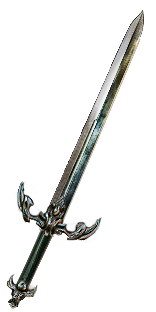
- ↑ Inscription III claims that Rigwald tracked down and killed Sentari with the aid of the Greatwolf. However, this contradicts Book 2 of the Purity Chronicles.
- ↑ The date of this event is unknown. Origins #1 pg. 1 claims that this occured 4 years before the Cataclysm. However, this is contradicted by in-game accounts that state that Voll's reign lasted around 5 years. This event has been placed first because it is the first event mentioned in the Purity Chronicles.
- ↑ Path of Exile: Origins, "The Karui Way", pg. 4
- ↑ Bestel, "Marceus Lioneye"
- ↑ Path of Exile: Origins, "The Karui Way", pg. 9
- ↑ Maramoa, "The Purity Rebellion"
- ↑ See Lioneye's bow-related items, like
 Lioneye's GlareLioneye's Glare
Lioneye's GlareLioneye's Glare
Imperial BowBow
Physical Damage: (100.8-129) to (394.8-453)
Critical Strike Chance: 5.00%
Attacks per Second: (1.59-1.74)Requires Level 66, 212 Dex(20-24)% increased Elemental Damage with Attack Skills(180-200)% increased Physical Damage
Adds (7-14) to (24-34) Physical Damage
(10-20)% increased Attack Speed
+(80-100) to maximum Mana
Hits can't be Evaded
Far Shot"See without doubt, slay without hesitation."
- Marceus Lioneye of Sarn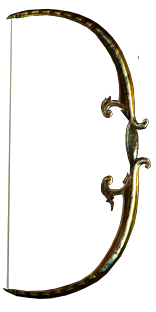 and
and  Lioneye's PawsLioneye's Paws
Lioneye's PawsLioneye's Paws
Bronzescale BootsArmour: (55-63)
Evasion: (55-63)Requires Level 30, 30 Str, 30 DexTrigger Level 5 Rain of Arrows when you Attack with a Bow
+(40-60) to Strength
+(40-60) to Dexterity
Adds 12 to 24 Fire Damage to Attacks
20% increased Movement Speed
40% reduced Movement Speed when on Low LifeStand and lead the righteous pride,
Fight till death, never hide.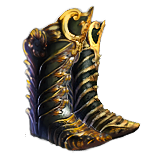 .
.
- ↑ Bestel, "Marceus Lioneye"
- ↑ Path of Exile: Origins, "The Karui Way", pg. 11
- ↑ Path of Exile: Origins, "The Karui Way", pg. 10
- ↑ Lavianga, Weathered Carving, The Coast (Act 1)
- ↑
 Volley FireVolley Fire
Volley FireVolley Fire
Viridian JewelLimited to: 1
Radius: Medium(7-10)% increased Projectile Damage
With at least 40 Dexterity in Radius, Barrage fires an additional 6 projectiles simultaneously on the first and final attacksLioneye's men stood at the walls,
eyeing the savages that walked the beach below.
With a single word,
a thousand bodies, and ten thousand arrows,
would litter the sands.Place into an allocated Jewel Socket on the Passive Skill Tree. Right click to remove from the Socket.
- ↑
 BroadstrokeBroadstroke
BroadstrokeBroadstroke
Heavy QuiverRequires Level 5Adds 1 to 4 Physical Damage to Attacks30% increased Global Physical Damage
(10-15)% reduced Enemy Stun Threshold
(20-30)% increased Stun Duration on EnemiesSeeing only foot soldiers, the Sarn Knights cast aside
their heavy shields... and paid dearly for their mistake.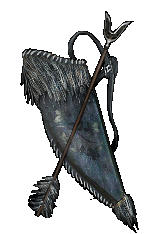
- ↑ Garivaldi, "The Purity Chronicles", "Book 3: Fall of a Jade Axe"
- ↑
 Hyrri's IreHyrri's Ire
Hyrri's IreHyrri's Ire
Zodiac LeatherEvasion: (2049-3142)
Movement Speed: -3%Requires Level 65, 197 Dex+(40-50) to Dexterity
(140-220)% increased Evasion Rating
25% increased Chill Duration on Enemies
(105-145) to (160-200) Added Cold Damage with Bow Attacks
+30% chance to Suppress Spell DamageHyrri loosed a barrage of arrows,
tipped with a poisoned hatred
only oppression can ferment.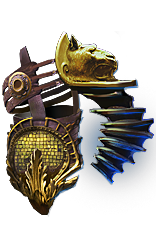
- ↑ Garivaldi, "The Purity Chronicles", "Book 3: Fall of a Jade Axe"
- ↑
 The Lion
The Lion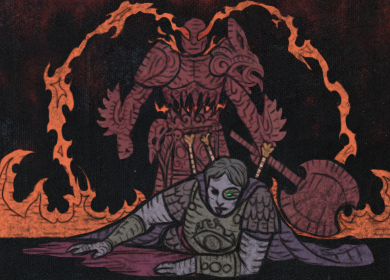 The Lion
The Lion 5Lioneye ItemThe Eternals lauded his valour. The Karui relished his defeat. Yet the final thoughts of Marceus Lioneye were naught but lament for his pride.
5Lioneye ItemThe Eternals lauded his valour. The Karui relished his defeat. Yet the final thoughts of Marceus Lioneye were naught but lament for his pride.
- ↑ Path of Exile: Origins, "The Karui Way", pg. 17
- ↑ Path of Exile: Origins, "The Karui Way", pg. 21
- ↑
 Overwhelming OddsOverwhelming Odds
Overwhelming OddsOverwhelming Odds
Crimson JewelLimited to: 1
Radius: Medium(10-15)% increased Global Physical Damage
With at least 40 Strength in Radius, Hits with Cleave Fortify
With at least 40 Strength in Radius, Cleave has +0.1 metres to Radius per Nearby
Enemy, up to a maximum of +1 metreEven as the tide turned, and victory swiftly became impossible,
The legionnaires of Lioneye's Watch stood their ground and fought on,
Every last man dying a brutal but honourable death.Place into an allocated Jewel Socket on the Passive Skill Tree. Right click to remove from the Socket.
- ↑ Unknown, "Distant Lush Crater Memory"
- ↑ Lavianga, "Weathered Carving", The Coast (Act 1)
- ↑
 Lioneye's FallLioneye's Fall
Lioneye's FallLioneye's Fall
Viridian JewelRadius: MediumMelee and Melee Weapon Type modifiers in Radius are Transformed to Bow ModifiersThe shield crab does not leave his shell unless it is forced to,
and even then, it knows to keep its distance.Place into an allocated Jewel Socket on the Passive Skill Tree. Right click to remove from the Socket.
- ↑
 Lioneye's RemorseLioneye's Remorse
Lioneye's RemorseLioneye's Remorse
Pinnacle Tower ShieldChance to Block: 30%
Armour: (1307-1718)
Movement Speed: -3%Requires Level 70, 159 Str+(20-30) to maximum Life(180-220)% increased Armour
20% increased Stun and Block Recovery
+(160-180) to maximum Life
5% reduced Movement Speed
-25 Physical Damage taken from Projectile Attacks
+5% Chance to BlockMarceus' unblemished shield is a testament
to his arrogance... and his fate.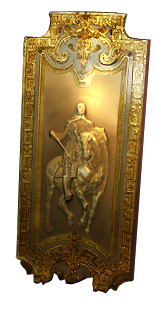
- ↑ Garivaldi, "The Purity Chronicles", "Book 3: Fall of a Jade Axe"
- ↑ Lavianga, "Weathered Carving", The Tidal Island (Act 1)
- ↑ Shavronne is referred to as "of Umbra", she is sometimes referred to simply as "the Umbra" and Kadavrus is referred to as "Surgeon to the Umbra". However it is unclear what Umbra is or means.
- ↑ Shavronne, "Shavronne's Journal"
- ↑
 Shavronne's PaceShavronne's Pace
Shavronne's PaceShavronne's Pace
Scholar BootsEnergy Shield: (46-60)Requires Level 32, 59 Int+(20-30) to Intelligence
(100-140)% increased Energy Shield
(150-200)% increased Stun and Block Recovery
15% increased Movement Speed
20% increased Movement Speed when on Full LifeShavronne raced to Brutus' side,
her last hope against the Karui tide.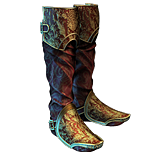
- ↑ Nessa, "Brutus"
- ↑
 Shavronne's RevelationShavronne's Revelation
Shavronne's RevelationShavronne's Revelation
Moonstone RingRequires Level 30+(15-25) to maximum Energy Shield+(60-75) to Intelligence
Right ring slot: You cannot Regenerate Mana
Right ring slot: Regenerate 6% of Energy Shield per second
Right ring slot: +250 to maximum Mana
Left ring slot: You cannot Recharge or Regenerate Energy Shield
Left ring slot: Regenerate 40 Mana per Second
Left ring slot: +250 to maximum Energy Shield"Shavronne held Sanity in her right
hand and Revelation in her left.
Brutus chose the left hand."
- Kadavrus, Surgeon to the Umbra
- ↑ Piety, "The Godless Three"
- ↑ Lavianga, "Weathered Carving", The Ship Graveyard
- ↑ Eramir, "Blocked Passage"
- ↑ Lavianga, "Weathered Carving", The Mud Flats (Act 1)
- ↑ Lavianga, "Weathered Carving", The Ledge
- ↑ Lavianga, "Weathered Carving", The Climb
- ↑ Kaom, "Weathered Carving", Kaom's Stronghold I
- ↑ Lavianga, "Weathered Carving", The Ship Graveyard II
- ↑
 The King's Heart
The King's Heart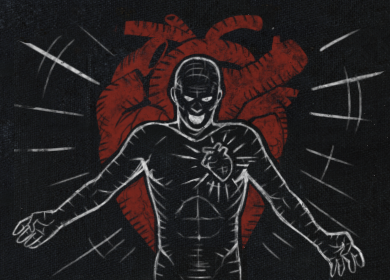 The King's Heart
The King's Heart 8
8 Kaom's Heart
Kaom's Heart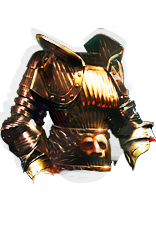 500 times Kaom's axe fell, 500 times Kaom's Heart splintered. Finally, all that remained was a terrible, heartless Fury.
500 times Kaom's axe fell, 500 times Kaom's Heart splintered. Finally, all that remained was a terrible, heartless Fury.
- ↑ Kaom, "Weathered Carving", Kaom's Dream II
- ↑ Oyun, "Kaom"
- ↑ While the rising of the dead seems to suggest that these events occurred post-Cataclysm, Kaom is clearly still present during all of these events. Malachai's Notebook refers to "Fury and Desire", which may suggest that he needed Kaom to be there before activating the Cataclysm.
- ↑ Leo, "Hector Titucius"
- ↑ Hargan, "Hector Titucius"
- ↑ Hargan, "The Wings of Vastiri"
- ↑
 Frozen TrailFrozen Trail
Frozen TrailFrozen Trail
Cobalt JewelLimited to: 2
Radius: Medium(7-10)% increased Projectile Damage
With at least 40 Intelligence in Radius, Frostbolt Projectiles gain 40% increased Projectile Speed per second
With at least 40 Intelligence in Radius, Frostbolt fires 2 additional ProjectilesThe Maraketh knew that a mountain path
free of vegetation was cut by regular avalanches,
and so the advancing Eternals were unwittingly drawn into a deathtrap.Place into an allocated jewel socket on the Passive Skill Tree. Right click to remove from the Socket. and
and  Careful PlanningCareful Planning
Careful PlanningCareful Planning
Viridian JewelRadius: Large+(16-24) to Dexterity
Intelligence from Passives in Radius is Transformed to DexterityCorrupted"Greatly outnumbered, Deshret dressed her personal guard in identical garb. When the Empire rode north, Deshret and her guard took turns revealing themselves, creating the illusion of speed beyond the capabilities of even the Virtue Gems."
- History of the MarakethPlace into an allocated Jewel Socket on the Passive Skill Tree. Right click to remove from the Socket. may describe this battle or similar, possibly contemporaneous Maraketh victories over Eternals. However, they have not been included as their depicted events are not backed up by any other sources.
may describe this battle or similar, possibly contemporaneous Maraketh victories over Eternals. However, they have not been included as their depicted events are not backed up by any other sources.
- ↑ Path of Exile: Origins, "Sons of Virtue", pg. 7
- ↑ Helena, "The Baleful Gem"
- ↑ Path of Exile: Origins, "Sons of Virtue", pg. 10
- ↑ Path of Exile: Origins, "Sons of Virtue", pg. 21
- ↑ Piety, "The Godless Three"
- ↑ Voll, "Proclamation"
- ↑
 Widowsilk RobeWidowsilk RobeEnergy Shield: (157-181)
Widowsilk RobeWidowsilk RobeEnergy Shield: (157-181)
Movement Speed: -3%Requires Level 65, 187 Int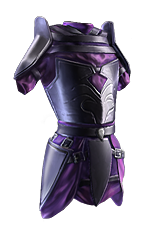
- ↑ Helena, "Maligaro"
- ↑ Garivaldi, "The Purity Chronicles", "Book 5: The Emperor is dead. Long live the Emperor!"
- ↑ Path of Exile: Origins, "Death to Sin", pg. 5
- ↑ Hargan, "Victario"
- ↑ Path of Exile: Origins, "Death to Sin", pg. 8
- ↑ Leo, "Sarn Arena" may be referring to this event.
- ↑ Path of Exile: Origins, "Death to Sin", pg. 10
- ↑
 Combat Focus (Cobalt Jewel)Combat Focus
Combat Focus (Cobalt Jewel)Combat Focus
Cobalt JewelLimited to: 2
Radius: Medium(10-15)% increased Elemental Damage
With 40 total Intelligence and Dexterity in Radius, Prismatic Skills cannot choose Fire
With 40 total Intelligence and Dexterity in Radius, Prismatic Skills deal 50% less Fire DamageVoll stood at the gates of Sarn, and a nation stood behind him.
He thought of the righteousness of his cause,
and of the glory he would bring to the empire he would soon lead.
But as Chitus and his gemlings advanced, he thought only of the fight.Place into an allocated Jewel Socket on the Passive Skill Tree. Right click to remove from the Socket.
- ↑ Dialla, "Introduction"
- ↑ Dialla, "Malachai"
- ↑
 Victario's FlightVictario's Flight
Victario's FlightVictario's Flight
Goathide BootsEvasion: (84-135)Requires Level 12, 26 Dex+15 to Dexterity
+15 to Intelligence
(100-150)% increased Evasion Rating
(10-20)% increased Movement Speed
(10-20)% increased Movement Speed when on Low Life
Quicksilver Flasks you Use also apply to nearby AlliesAlive but not unscathed, Victario fled
as slaughter blossomed at the gates.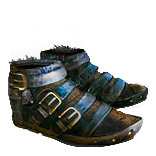
- ↑ Rigwald, "Inscription" IV
- ↑ Path of Exile: Origins, "The Black Heart", pg 8
- ↑ While the orders refer to a "warehouse", the legion is later encountered in the Grain Gate. This is because they were previously encountered in the removed Warehouse District area.
- ↑ Maramoa, "The Gemling Legion"
- ↑ Path of Exile: Origins, "The Black Heart", pg 11
- ↑ Path of Exile: Origins, "The Black Heart", pg 14
- ↑ Path of Exile: Origins, "The Black Heart", pg 12
- ↑ While Origins depicts Chitus being impaled through the chest, Fairgraves claims that he was stabbed through the "posterior".
- ↑ The weapon that dealt the killing blow is up for debate. Ondar, the Betrayer's model shows him wielding a claw, and a claw is depicted in Origins. However,
 Ondar's ClaspOndar's Clasp
Ondar's ClaspOndar's Clasp
Wrapped MittsEvasion: (11-15)
Energy Shield: (3-5)Requires Level 530% increased Attack Speed when on Full Life
Adds (1-4) to (30-50) Lightning Damage to Attacks
+(100-200) to Accuracy Rating
20% increased Movement Speed when on Low LifeA single lightning strike fells a man.
A single knife stroke fells an empire.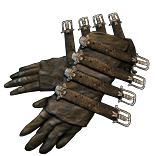 refers to a knife.
refers to a knife.
- ↑ Ondar, "Pristine Palace Memory"
- ↑ Garivaldi, "The Purity Chronicles", "Book 5: The Emperor is dead. Long live the Emperor!"
- ↑ Captain Fairgraves, "Chitus' Plum"
- ↑ "Warehouse" refers to the removed areas The Warehouse Sewers and The Warehouse District
- ↑ Garivaldi, "The Purity Chronicles", "Book 5: The Emperor is dead. Long live the Emperor!"
- ↑
 Perandus BlazonPerandus Blazon
Perandus BlazonPerandus Blazon
Cloth BeltRequires Level 16(15-25)% increased Stun and Block Recovery+(20-30) to all Attributes
(6-8)% increased Quantity of Items found
+20% to Fire Resistance
20% increased Flask Effect Duration
-2 Physical Damage taken from Attack HitsA large enough debt turns even a friend
into an enemy, and the Perandus family
had more debtors than anyone.
- ↑
 Emperor of Purity
Emperor of Purity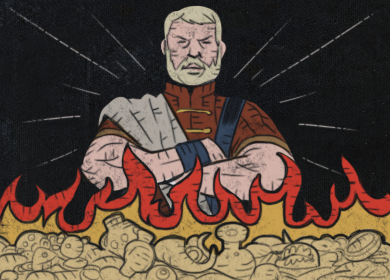 Emperor of Purity
Emperor of Purity 7Six-Link Holy Chainmail
7Six-Link Holy Chainmail
Item Level: 60True to his title,
Voll, newly crowned,
had many of the
Eternal Empire's signature
extravagances destroyed.
- ↑ Siosa, "Malachai"
- ↑ Victario,
 The Brittle Emperor
The Brittle Emperor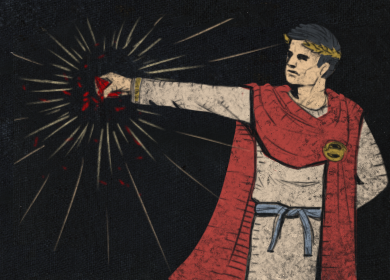 The Brittle Emperor
The Brittle Emperor 8
8 Voll's Devotion
Voll's Devotion
Corrupted"When Voll spared Malachai, accepting his aid in pursuit of Purity, the strongest faith was infected by Corruption and made brittle as glass."
- Victario, the People's Poet
- ↑ Piety, "Malachai
- ↑ Dialla, "Malachai
- ↑ Garivaldi, "The Purity Chronicles", "Book 6: The Rapture Device"
- ↑
 Omen on the WindsOmen on the Winds
Omen on the WindsOmen on the Winds
Viridian JewelLimited to: 2
Radius: Medium(15-20)% increased Damage with Hits against Chilled Enemies
With at least 40 Dexterity in Radius, Ice Shot has 25% increased Area of Effect
With at least 40 Dexterity in Radius, Ice Shot Pierces 3 additional TargetsAs Malachai stepped into the Highgate mines,
cold winds billowed from the mountain above.
One final, feeble attempt to save what was meant to be eternal.Place into an allocated Jewel Socket on the Passive Skill Tree. Right click to remove from the Socket.
- ↑ Malachai, "Malachai's Notebook"
- ↑ Petarus and Vanja, "Daresso"
- ↑ Merveil, "Damp Diary"
- ↑ Piety, "Malachai"
- ↑ Malachai, "Malachai's Notebook"
- ↑ Piety, "The Godless Three"
- ↑ Piety, "Malachai's Organs"
- ↑ Lady Dialla, "Malachai"
- ↑ Grigor, "The Gemling Queen"
- ↑ Templar, on The Solaris Temple
- ↑ Scion, on the Slums
- ↑ Divinia, "The Bridge Encampment"
- ↑ Divinia, "Wildlife
- ↑ Yeena, "Blood Apes"
- ↑ Yeena, "Elementals"
- ↑
 Spreading RotSpreading Rot
Spreading RotSpreading Rot
Cobalt JewelLimited to: 1
Radius: Medium(7-13)% increased Chaos Damage
With at least 40 Intelligence in Radius, Blight inflicts Withered for 2 seconds
With at least 40 Intelligence in Radius, Blight has 30% reduced Cast SpeedThe Cataclysm was but the first act in a play of horrors.
The dead lingered, and the living began to rot.Place into an allocated Jewel Socket on the Passive Skill Tree. Right click to remove from the Socket.
- ↑ Victario, "Ancient Notebook"
- ↑ Tentacles can be observed growing out of the body of Voll, Emperor of Purity
- ↑ Siosa, "Cataclysm"
- ↑ Siosa, "Cataclysm" specifically mentioning Trinian "englufed by the radiance" of his gem, Victario, "Ancient Notebook" specifically mention gems "flar[ing] in unholy lustre"
- ↑ Victario, "Ancient Notebook"
- ↑ Siosa, "Cataclysm"
- ↑ Ahuana, "Cataclysm"
- ↑ Oyun, "Deshret"
- ↑
 Spreading RotSpreading Rot
Spreading RotSpreading Rot
Cobalt JewelLimited to: 1
Radius: Medium(7-13)% increased Chaos Damage
With at least 40 Intelligence in Radius, Blight inflicts Withered for 2 seconds
With at least 40 Intelligence in Radius, Blight has 30% reduced Cast SpeedThe Cataclysm was but the first act in a play of horrors.
The dead lingered, and the living began to rot.Place into an allocated Jewel Socket on the Passive Skill Tree. Right click to remove from the Socket.
- ↑ Maramoa, "Gemling Legionaires"
- ↑ Captain Fairgraves, "The Undying"
- ↑ Maramoa, "The Undying"
- ↑ Sin, "Trarthan Powder"
- ↑ Oyun, "Voll"
- ↑
 Fight for SurvivalFight for Survival
Fight for SurvivalFight for Survival
Viridian JewelLimited to: 2
Radius: Medium(10-15)% increased Cold Damage
With at least 40 Dexterity in Radius, Melee Damage
dealt by Frost Blades Penetrates 15% Cold Resistance
With at least 40 Dexterity in Radius, Frost Blades has 25% increased Projectile SpeedThe winter that followed the Cataclysm was especially harsh.
Wraeclast's few survivors fought to the death for the last scraps of bread.Place into an allocated jewel socket on the Passive Skill Tree. Right click to remove from the Socket.
- ↑
 The Long WinterThe Long Winter
The Long WinterThe Long Winter
Cobalt JewelLimited to: 2
Radius: Medium(10-15)% increased Cold Damage
With 40 Intelligence in Radius, Glacial Cascade has an additional Burst
With 40 Intelligence in Radius, 20% of Glacial Cascade Physical Damage
Converted to Cold DamageIn the years that followed the twisted sky,
cold winds cloaked Wraeclast in snow.
The pure-white blanket masked a black heart
that lay dormant deep beneath the earth.Place into an allocated Jewel Socket on the Passive Skill Tree. Right click to remove from the Socket.
- ↑
 Steel SpiritSteel Spirit
Steel SpiritSteel Spirit
Viridian JewelRadius: Medium(7-10)% increased Projectile Damage
With at least 40 Dexterity in Radius, each Spectral Throw Projectile gains 5% increased Damage each time it HitsThe Sekhema rode to the mountain,
With her tribe, devoted and strong.
And sewed shut the mouth of nightmare,
So that it would not consume her world.Place into an allocated Jewel Socket on the Passive Skill Tree. Right click to remove from the Socket.
- ↑ Oyun, "Deshret"
- ↑ Unknown, "Deep Dig Memory"; Zana, on Deep Dig Memory
- ↑ Oyun, "The Red Banner"
- ↑ Tasuni, "Deshret"
References
- ↑ Entries from Ancient Etchings
- ↑ Primeval Remnant: "Kalandra watched as the almighty titans fell, relegated to the innermost depths of the world, where horrific abominations awaited them.."
- ↑ "The Redblade Caldera": "Little did the Redblades know that they encroached upon our territory and we were largely indifferent to their plights."
- ↑ The Redblade: "Its forging marked the melding of man and Titan against the rising darkness."
- ↑ The Geomantic Gyre: "For their mortal allies, the last Titans forged a mighty staff, one that could safely hold the first unearthed virtue gem."
- ↑ Sin: "There was a time, before the Beast, bathed in the shadows of lost memory, when men and women like you could ascend. Through rareness of quality and adoration of their people, these few could reach out to the quickening mists of immortality and grasp the power of godhood."
- ↑ Descriptions of stained windows in the Chamber of Innocence. (Full quotes here)
- ↑ Various relics from the Forbidden Sanctum
- ↑ Sin: "The Beast didn't want to destroy, to corrupt, to terrorise. It simply existed to exist. I made it that way. (...)I created a Beast that would free humanity from the tyranny of Gods."
- ↑ Piety: "The Beast is the source of all thaumaturgy, the one power in this world that transforms 'what is real' into 'what is imagined'."
- ↑ Eramir: "a culture I've seen mentioned here and there in some of the most antique of texts"
- ↑ Eramir: "That ancient gateway to the northwest, it's a peculiar thing. Not of the Eternal Empire. It could be Vaal in origin..."
- ↑ Eramir: "These artifacts, and that ancient gateway to the northwest... crafted by the same hands, I'd venture. Vaal hands." dialogue of Deal with the Bandits quest
- ↑ Helena: "A man-crafted mountain of four sheer sides? Sounds like a pyramid. That's Vaal architecture."
- ↑ Rebuke of the Vaal: "Though the Vaal revered peace, it would have been suicide for any culture to rouse them to war." - Icius Perandus, Scholar to the Empire
- ↑ Rathpith Globe: "The Vaal emptied their slaves of beating hearts, and left a mountain of twitching dead."
- ↑ Bloodseeker: ""For the life of the flesh will always be in the blood." - Atalui, Vaal Priestess
- ↑ Eramir: "It is the Vaal who began the use of virtue gems, well before our imperial ancestors."
- ↑ Library book Raising the Azmeri:Yet while the Vaal were generous with their knowledge and guidance in many areas, there is one subject upon which they were notably silent; the Tears of Maji, now known as Virtue Gems.
- ↑ One of the Golden Page flavour texts reads: '"The Vaal were even more steeped in gem culture than our Emperor and his 'Gemlings'. It's an obsession as old as civilization itself." - Icius Perandus'
- ↑ Siosa: "They carried their virtue gems to... "Doryani's bed"... no, that's not quite right. Ah yes, Doryani's cradle. The historian finishes that it was a price they needed to pay to ensure a Vaalish future."
- ↑ Malachai's journal: "I possess only one reference that bears faith. Translated with unquestionable clarity by that idiot savant, Icius Perandus. "The Beast". Doryani of the Vaal knew the truth."
- ↑ The Vaults of Atziri map flavour text: "Should I depart this mortal coil, so shall all of my treasures." - Atziri, Queen of the Vaal
- ↑ Siosa: "Now here's a portentous line: 'She drenches her altars with the blood of those deranged enough to question her vision'
- ↑ Siosa: "Malachai would never have risen so far without the patronage of an emperor like Chitus. It would appear that Doryani and Queen Atziri shared a similar relationship."
- ↑ Siosa: "It was said of the beautiful Atziri that she "wished to see her likeness reflected in the still waters of history.". Chitus was no less self-impressed. Of all the Sins, Vanity is the most hideous."
- ↑ Siosa: "I suppose every civilization has its Doryani... its Malachai. Men of divine talent and demented ambition. Without them, history would be a far less 'interesting' place."
- ↑ Library book Zerphi the Murder
- ↑ Atziri's Mirror: "As long as I see death in my mirror, so will Wraeclast." - Atziri, Queen of the Vaal
- ↑ Waterfall Cave: "Two thousand years of regret"
- ↑ One of the Golden Page flavour texts reads: '"A communion... but with what? By all accounts, it wasn't God that the Vaal were trying to reach." - Icius Perandus'
- ↑ Siosa: "The next piece is a real eye-crosser, but I believe it refers to a 'communion', something to do with the harvest moon? Again, Doryani seems at the heart of it."
- ↑ Siosa: "Our queen is dead. Doryani is dead. So many have fallen. So many have changed."
- ↑ Siosa: "I can make out the words "sleep", "nightmare", and... "the Beast", whatever that may be. Our historian finishes with: We have succeeded where our forebears have not. We have failed ourselves"
- ↑ Siosa: "I need not imagine the fall of the Vaal. I saw the nightmare with my own eyes."
- ↑ Eramir: "The Azmeri. The culture that descended from the Azmerian Mountains and founded the Eternal Empire, so long ago."
- ↑ Math: Imperialus Conceptus happened 400 years after the Vaal fell (see later notes). According to Raising the Azmeri, "the first Vaal refugees came knocking five hundred years" after the Azmeri first encountered the Vaal.
- ↑ Library book Raising the Azmeri: Vaal civilisation held the hand of the Azmeri as they grew from a primitive tribal existence into a cohesive culture of settlement and agriculture
- ↑ Library book Raising the Azmeri: Though they described the Vaal as having flesh adorned with glittering crystals, our Azmerian ancestors were never privy to the gems’ potential or powers.
- ↑ Library book The Fall: "Three thousand one hundred and twenty-six: the number of Vaal refugees who came to live with and eventually become absorbed into the Azmerian people."
- ↑ 41.0 41.1 41.2 41.3 Natalia_GGG (Nov 11, 2020). "Path of Exile Lore: Questions and Answers Part One". Official Path of Exile Website. Retrieved December 24, 2023.
- ↑ 42.0 42.1 Bex_GGG (Feb 29, 2016). "The Perandus Challenge Leagues". Official Path of Exile Website. Retrieved December 14, 2023.
- ↑ Grinding Gear Games. "Path of Exile: Ascendancy". Official Path of Exile Website. Retrieved December 13, 2023.
- ↑ Unknown. "Kaom Steam Trading Card". Steam. Retrieved January 5, 2023.
- ↑ Grinding Gear Games. "Path of Exile: The Awakening". Official Path of Exile Website. Retrieved January 5, 2024.
- ↑ Unknown. "Geofri Steam Trading Card". Steam. Retrieved January 3, 2023.
- ↑ Nessa: "Karui savagery is nothing when compared to the ferocity that is Wraeclast."
- ↑ Tarkleigh: "The scavengers? Orphans of the Eternal Empire who've forgotten what it's like to be civilised."
- ↑ Tarkleigh: "...sooner or later corpses wake up and go looking for breakfast."
- ↑ Nessa: "Tarkleigh pulled Bestel from some hideaway in the wreckage."
- ↑ Letters of Exile: "God has charged me with your redemption. You are hereby Exiled to Wraeclast where, it is hoped, you shall come to repent your Sins, and make your peace with your beloved Father."
- ↑ Letter of Exile for Carling of Mirfield: "Civil Envy: One count of defaming a Church Official"
- ↑ The Letter of Exile for Kraityn of Theopolis lists 142 offences, including "One count of Matricide for Pecuniary Gain"
- ↑ Every Letter of Exile ends "the High Templar, Dominus"
- ↑ Tarkleigh: "We exiles have no history. Dominus took it from us the moment his Blackguards dumped us in the water out there."
- ↑ Maramoa: "Dominus' Ebony Legion arrived from Oriath a couple of full moons ago."
- ↑ Grigor: "It's the one key to the Sceptre of God [...] Dominus accessed his laboratory at the summit of the tower via a pulley system rigged to the outside wall."
- ↑ Maramoa: "General Gravicius demands absolute obedience from his Blackguards..."
- ↑ Hargan: "Gravicius is the mailed and bloodied right hand of Dominus."
- ↑ Grigor: "Unfortunately, Piety was simply a puppet of a greater force. You've cut the strings but the master remains: Dominus."
- ↑ Lady Dialla: "The cockroaches will come again. They want the Twist. That cockroach emperor... the other bugs shout his name. Gravicius."
- ↑ Lady Dialla says "The Ribbons' Spool is taken. Stolen. The black ones want them, my Ribbons. Want to wrap the city in black Ribbons." However, it's possible that she's mistaken and the Ebony Legion don't care about the Spool itself, so much as they just want to stop Lady Dialla from creating new Ribbons to replace the ones they've destroyed.
- ↑ Clarissa: "...the tie between Vinia and I endures. That was Piety's real name back in Theopolis..."
- ↑ Clarissa: "Vinia sold her thaumaturgy in the day, her body at night."
- ↑ Piety: "An exile, here? A shame the Warden won't leave anything for me to examine."
- ↑ Piety: "Find your own way inland, exile!"
- ↑ Helena: "To damnation with Piety! She was after one of Maligaro's creations, the Baleful Gem."
- ↑ Grigor: "Piety's a genius sculpting mere human clay into “divine” Gemlings. At least, that's what she told me when she opened me up and buried a Virtue Gem in my entrails."
- ↑ The Act 1 map shows the island of Oriath directly south of The Coves
- ↑ "For a while there I feared we were headed towards another theocratic dictatorship. Exile allowed me to be free of one." - Eramir's quest completion dialog for The Master of a Million Faces
- ↑ The Act 1 map shows a crown above the word 'Theopolis' on the island of Oriath
- ↑ Eramir: "Stumbled across sketches in the Theopolis archives, a piece of Vaal engineering, pyramidal in architecture."
- ↑ Hargan to the Duelist: "Now you're a familiar face! A face that cost me a good deal of coin at arenas in Theopolis."
- ↑ Hargan: "Had to smuggle a fellow out of Theopolis once. Got a bit too friendly with the Gravicius' wife, he did." Gravicius seems to be the head of the Ebony Legion, and it seems likely that his wife would be near him.
- ↑ Research Journal I: I have seen signs of blood and ancient sacrifice in the ghostings of our precious city! Such as what the Vaal would commit in their homelands. Could it be that these echoes point to Vaal culture having extended all the way to the shores of Oriath? Perhaps we are not the first empire to pull itself up from the mire of this land?
- ↑ Research Journal II: "Through my thaumaturgy, I was granted special sight, I saw the ancient Vaal city that once stood in this place. All around me were signs of the legendary Queen Atziri ruling from afar. I saw, as I stood at the base of a great pyramid, the sacrifice of new harvest unfold."
- ↑ Every Letter of Exile begins "Missive of Sentence, Court of Divine Temperance, Theopolis" in the previous version of the game. As of Version 3.15.0, it is not in the in-game Letter of Exile anymore
- ↑ Kahuturoa: "Oh... the Azmeri did set up an empire, and they died too? What's going on up there?! I suppose that golden cult they banished to Oriath is going to take over the world now!"
- ↑ Clarissa: "On the fall of the Empire, the historians are deathly silent. After the Purity Rebellion, the Kingdom of Kaom blockaded Oriath, preventing any trade or correspondence with the mainland." Apparently at the time of the Purity Rebellion, Oriath was developed enough to be reliably recording history and to want to trade with the Eternal Empire.
- ↑ Eramir: "The Fellshrine is a shadow of what was once good in Wraeclast. That sigil etched into its stones? It's a Descry, from when the Templar truly stood for something."